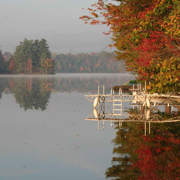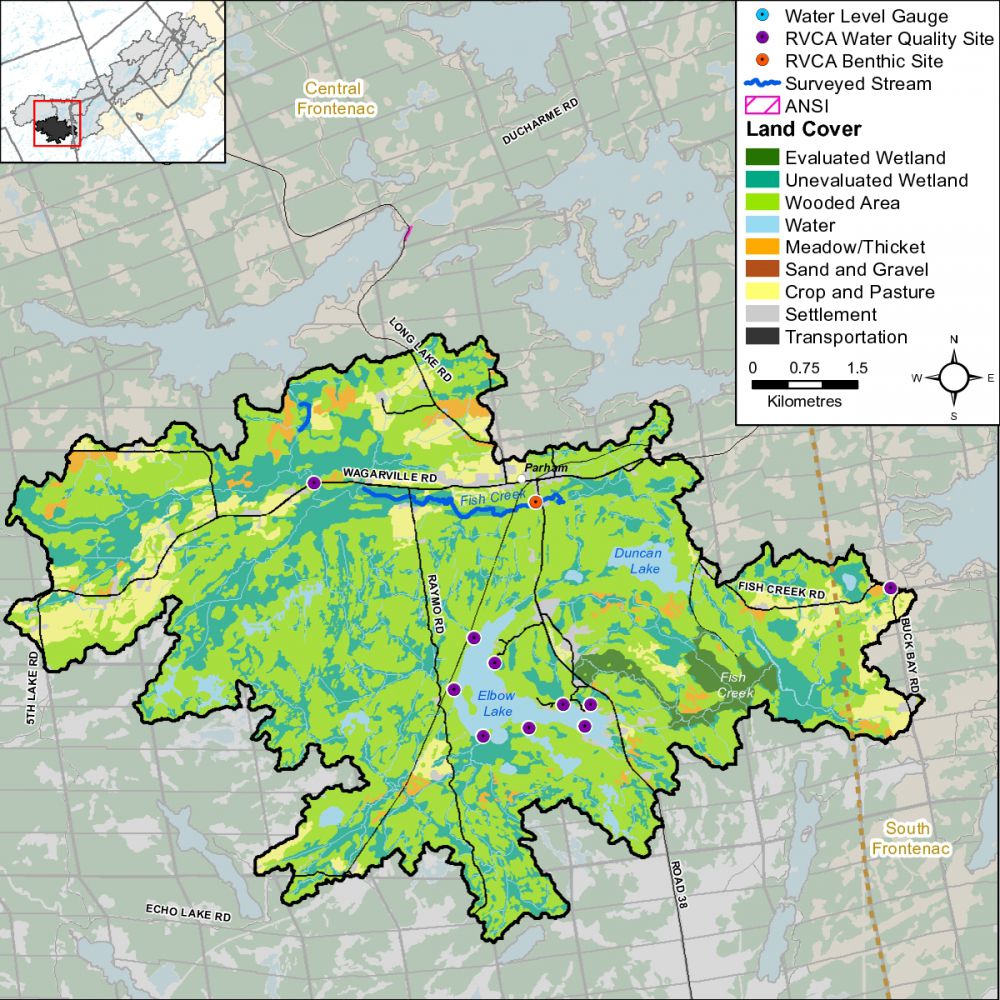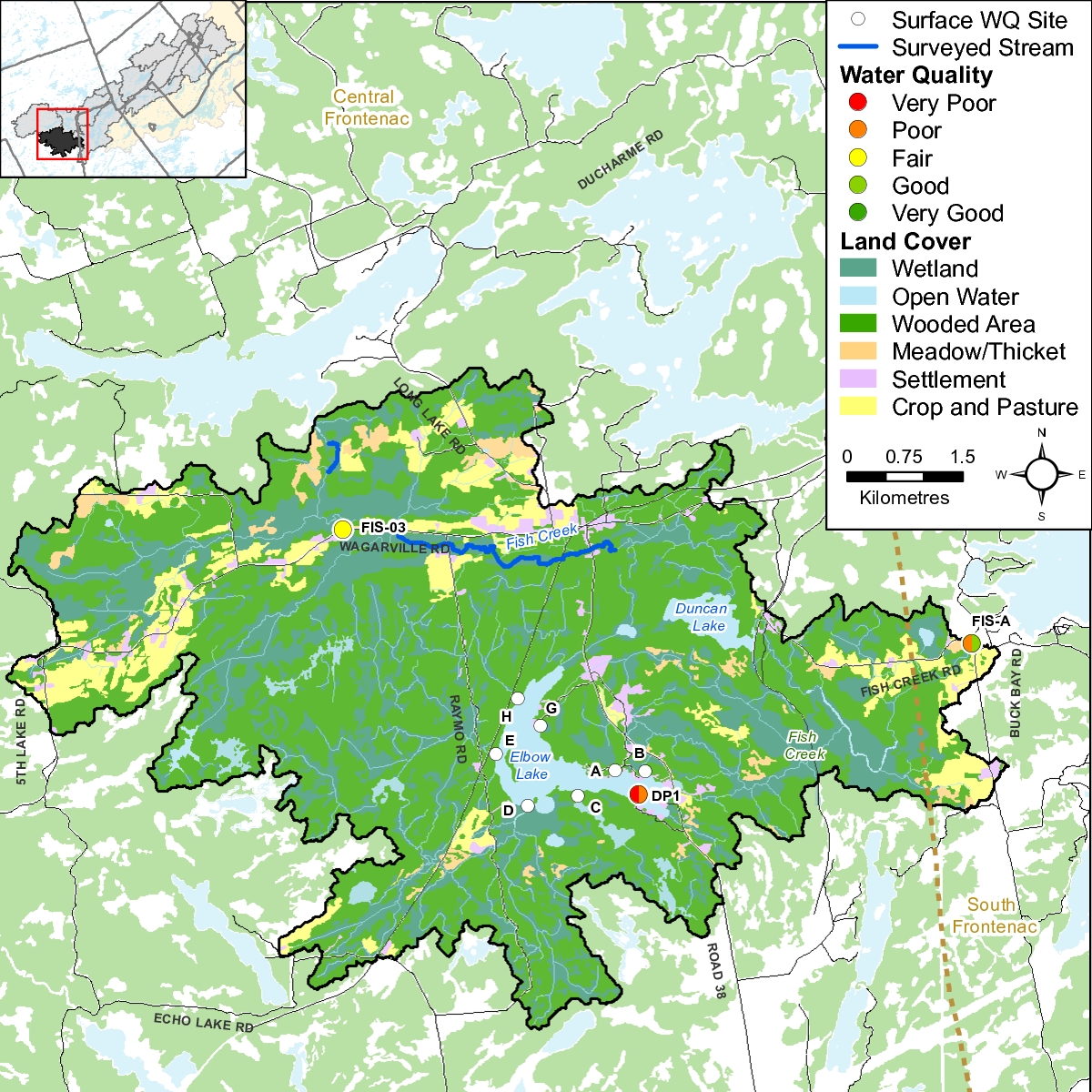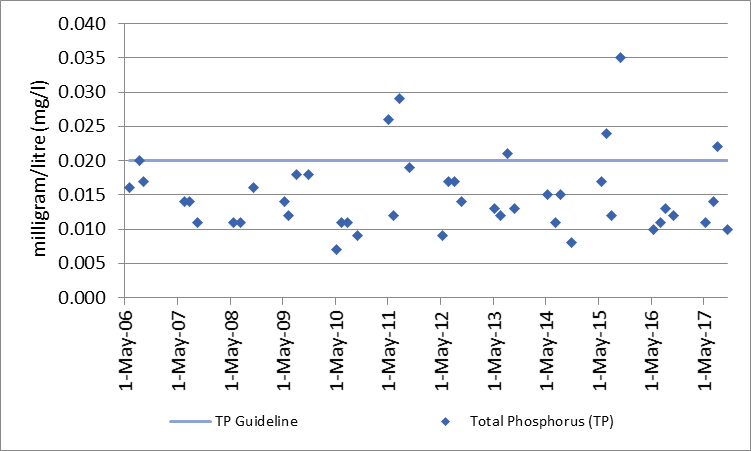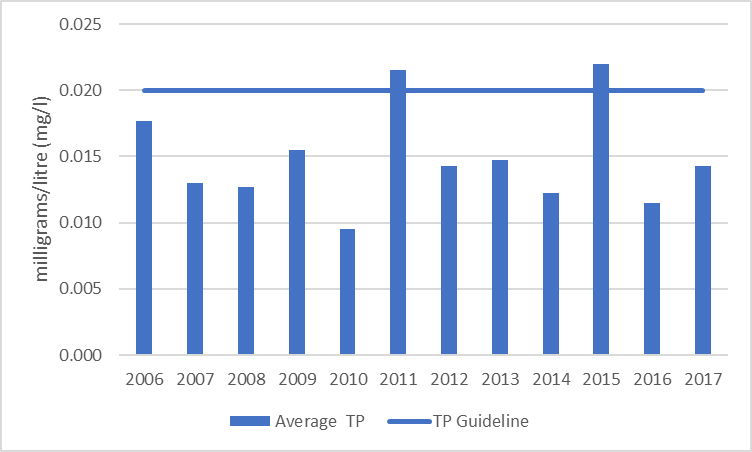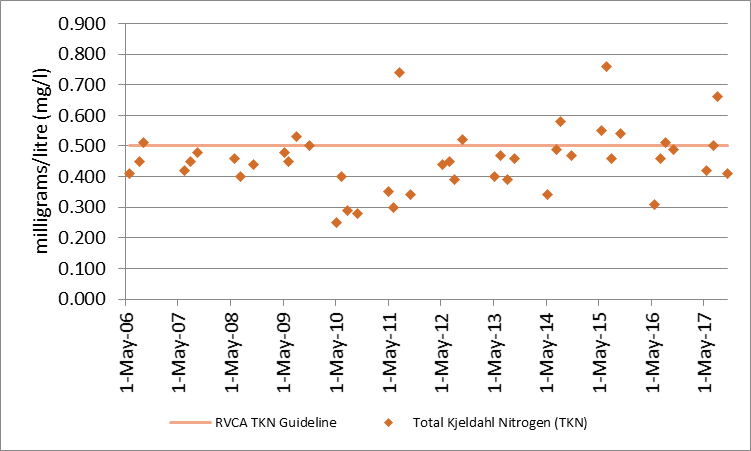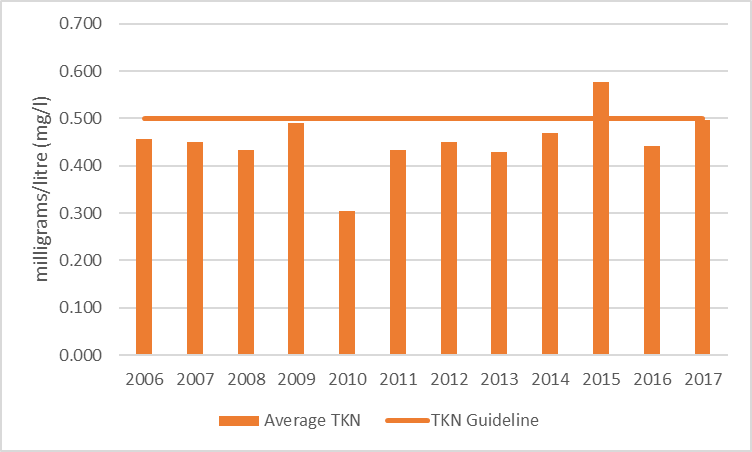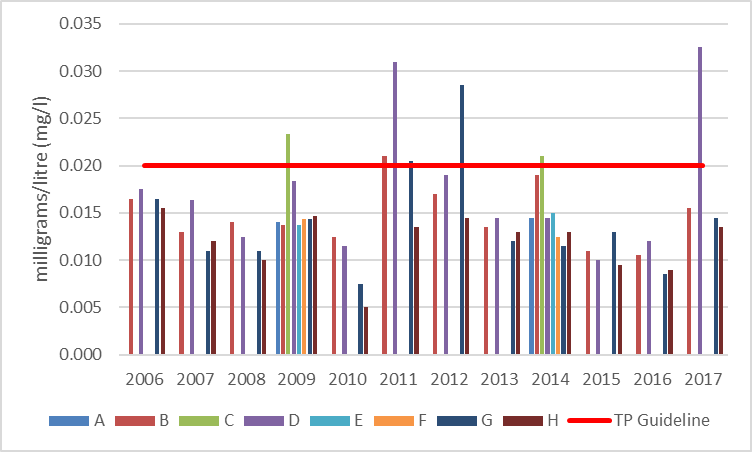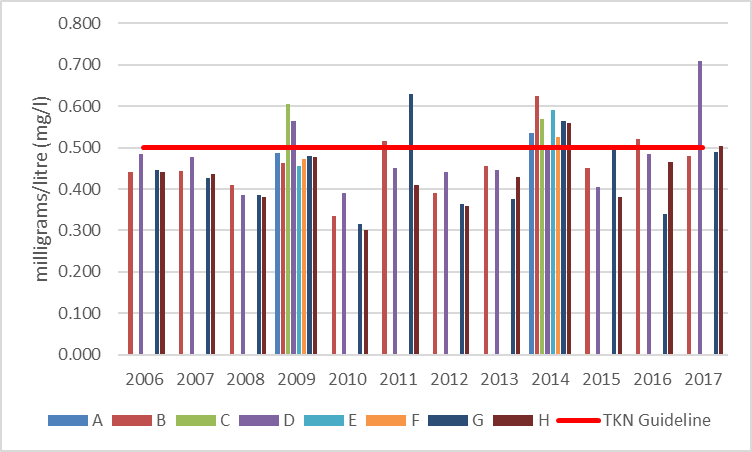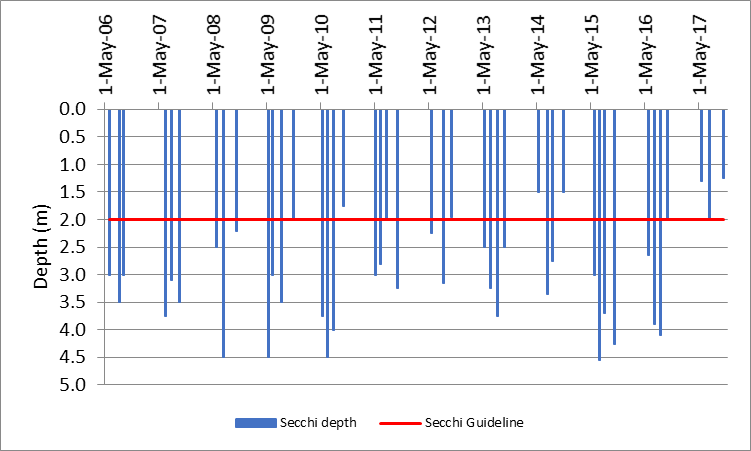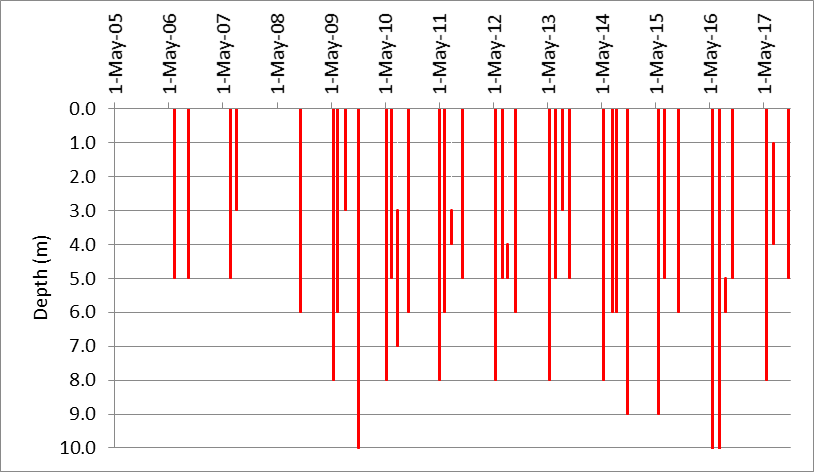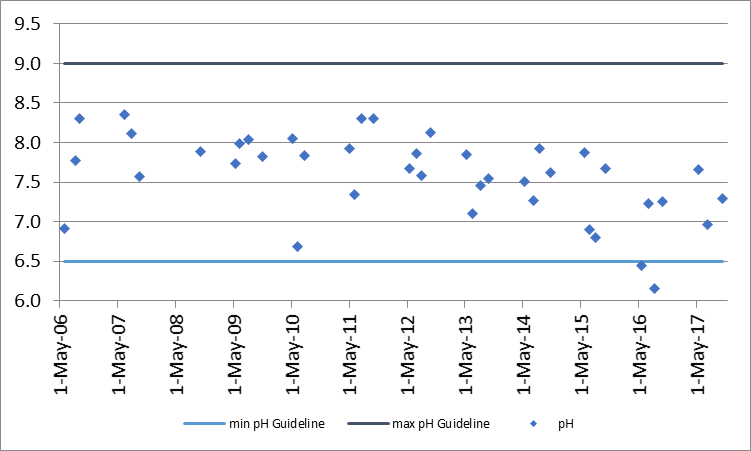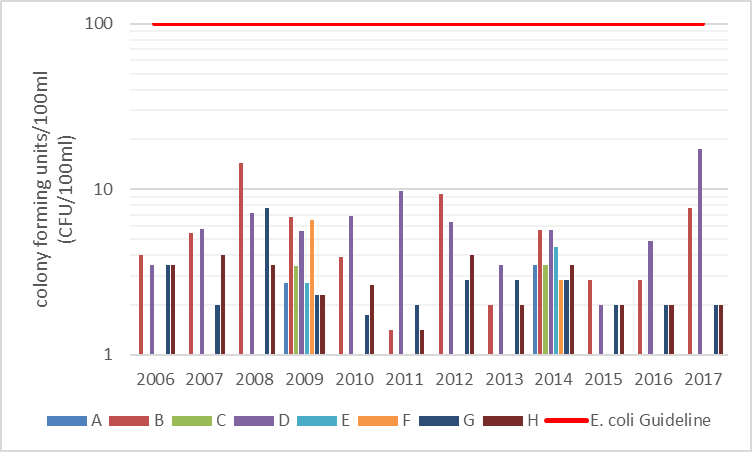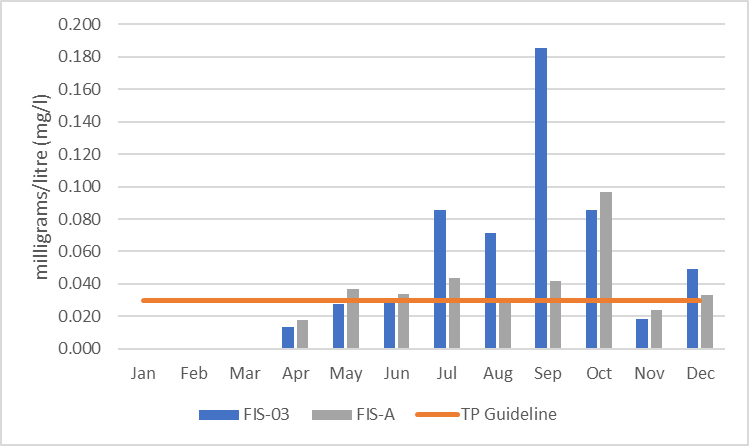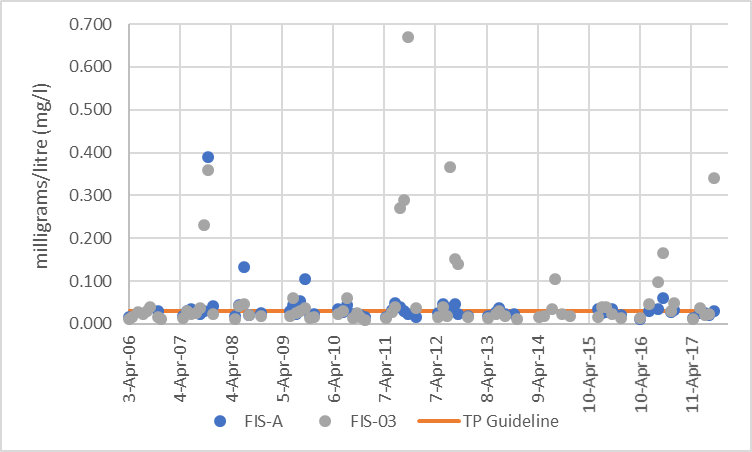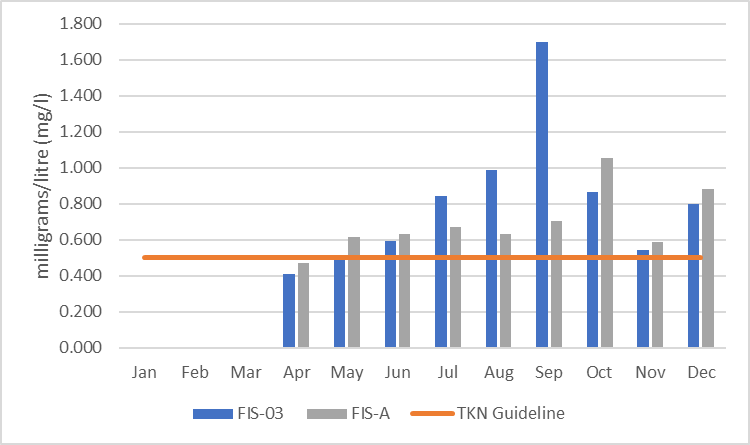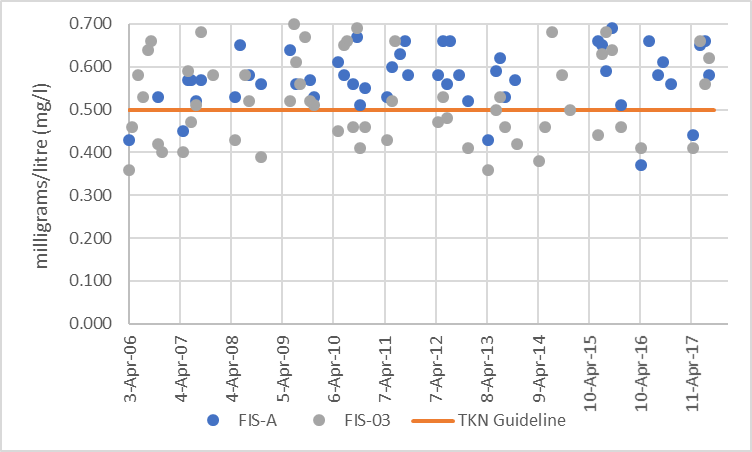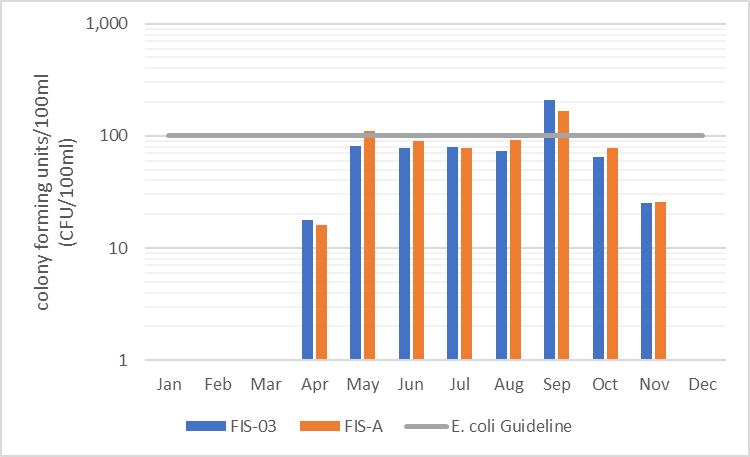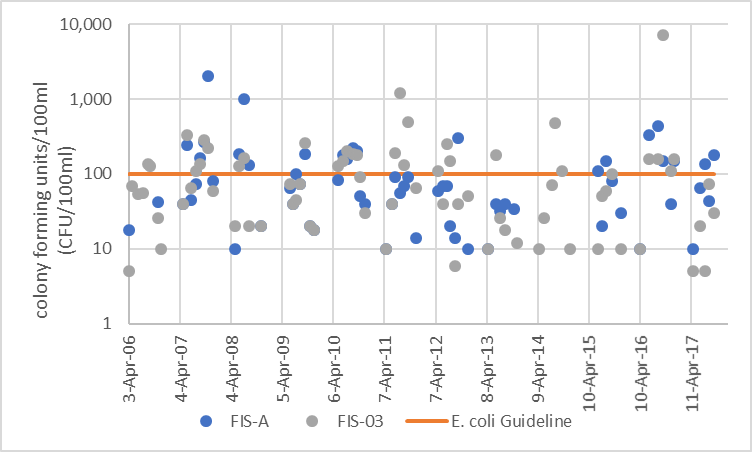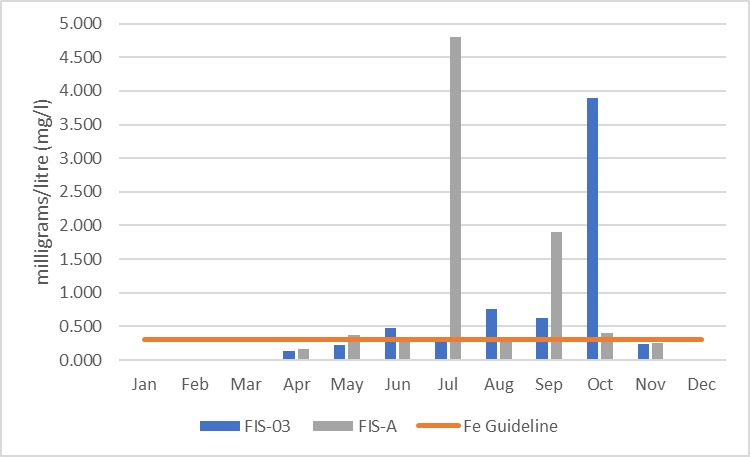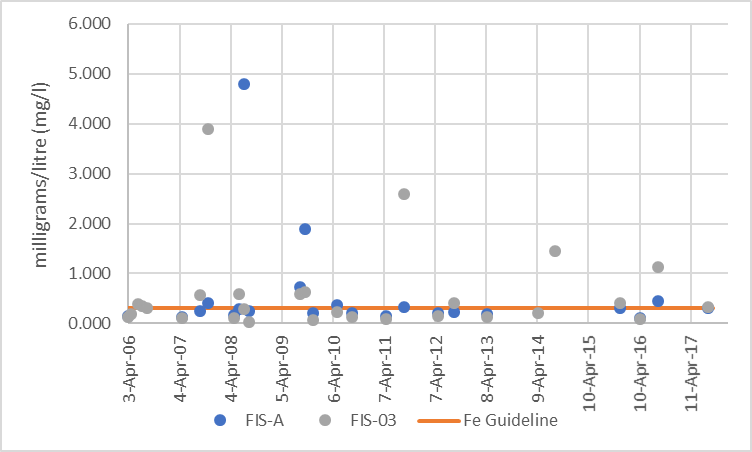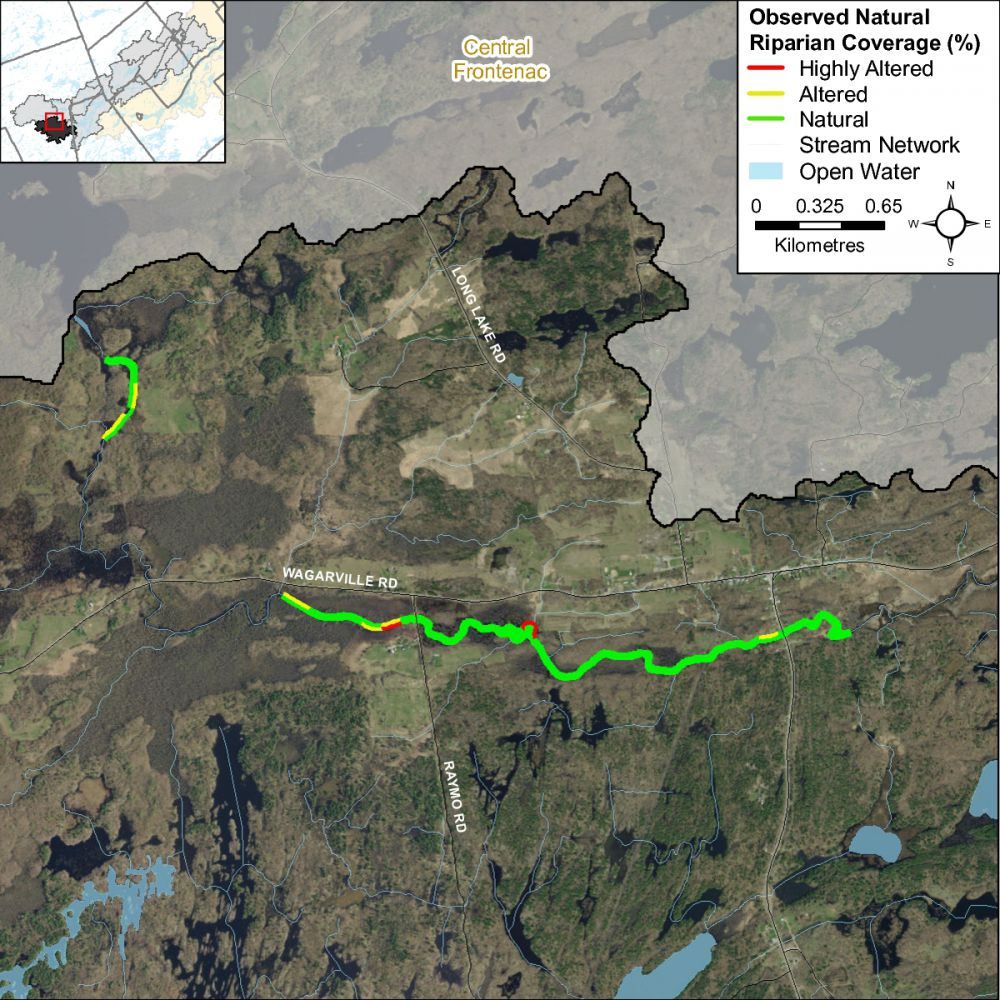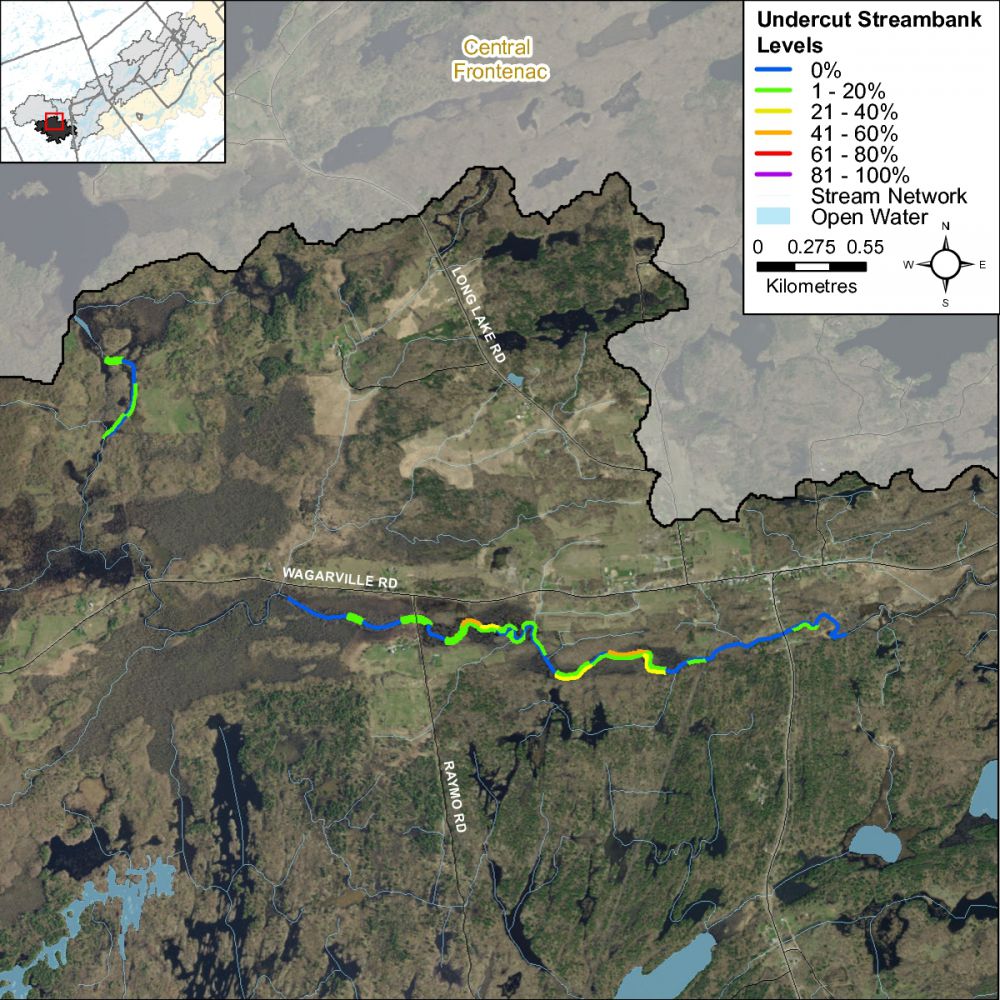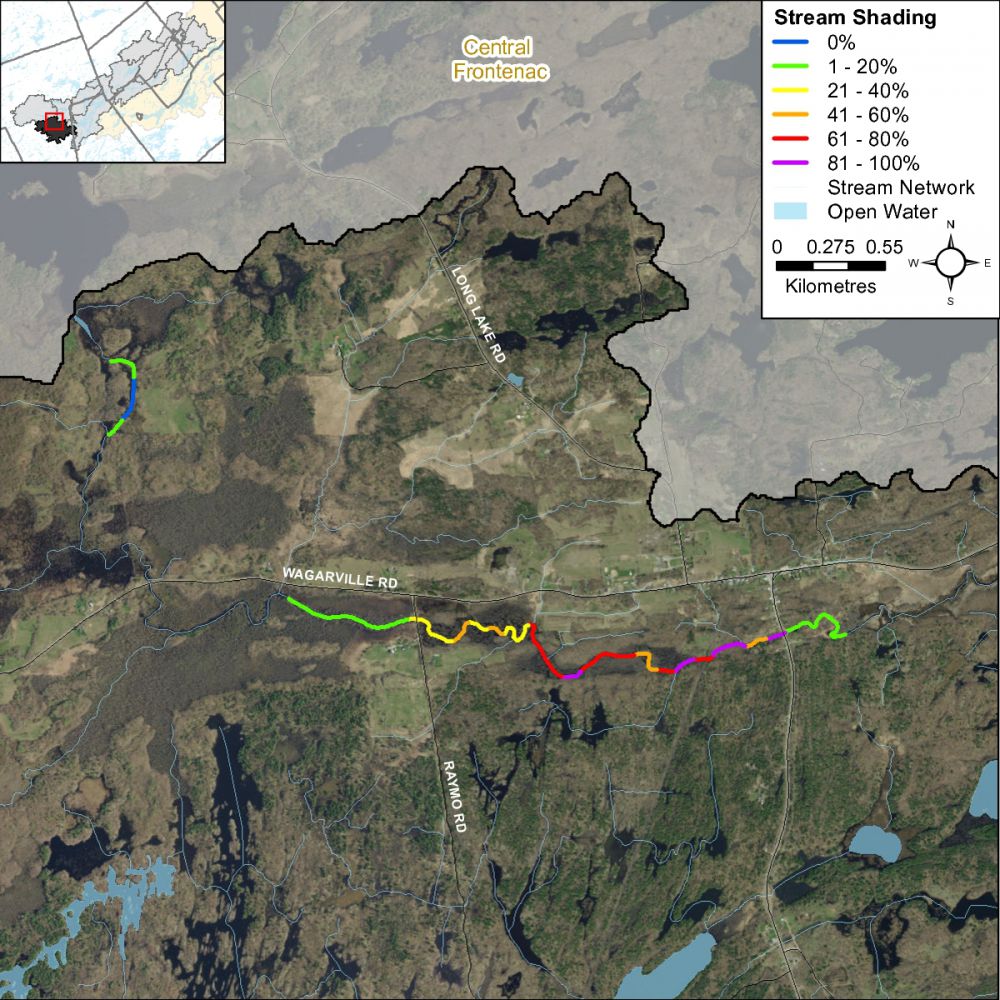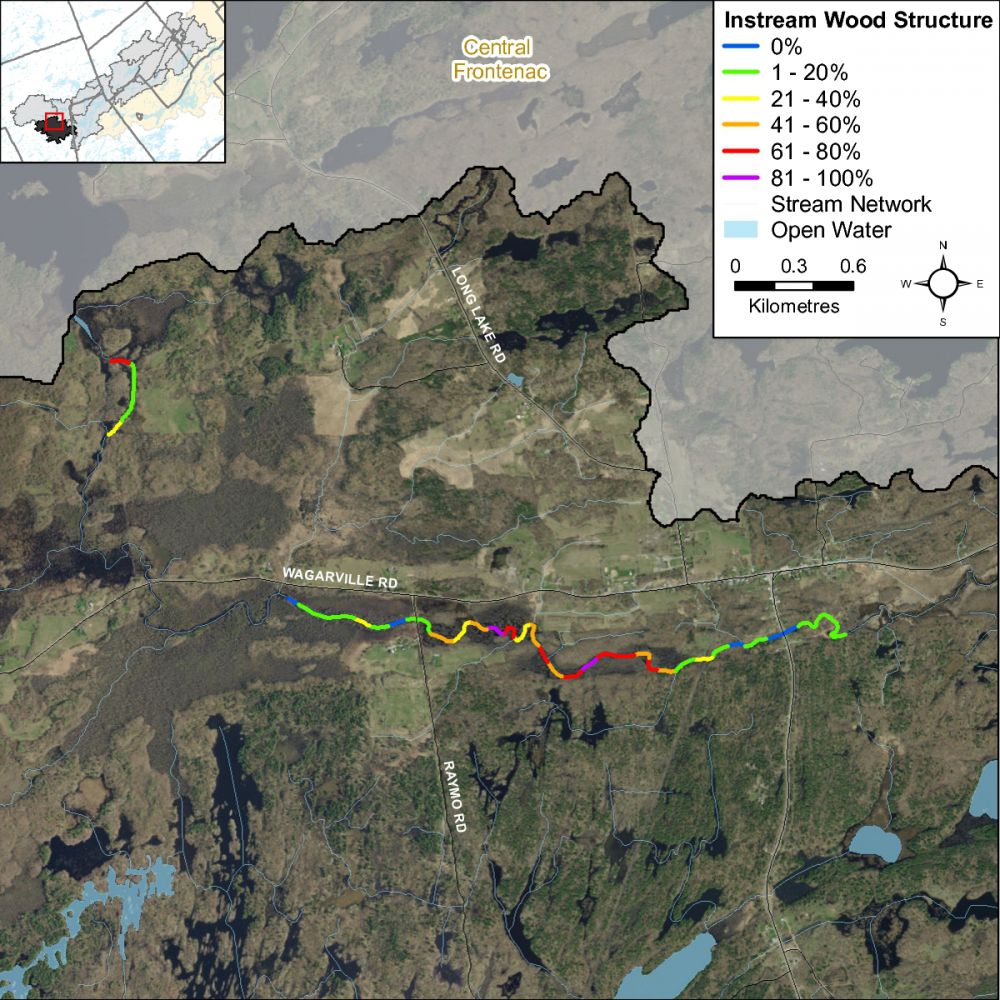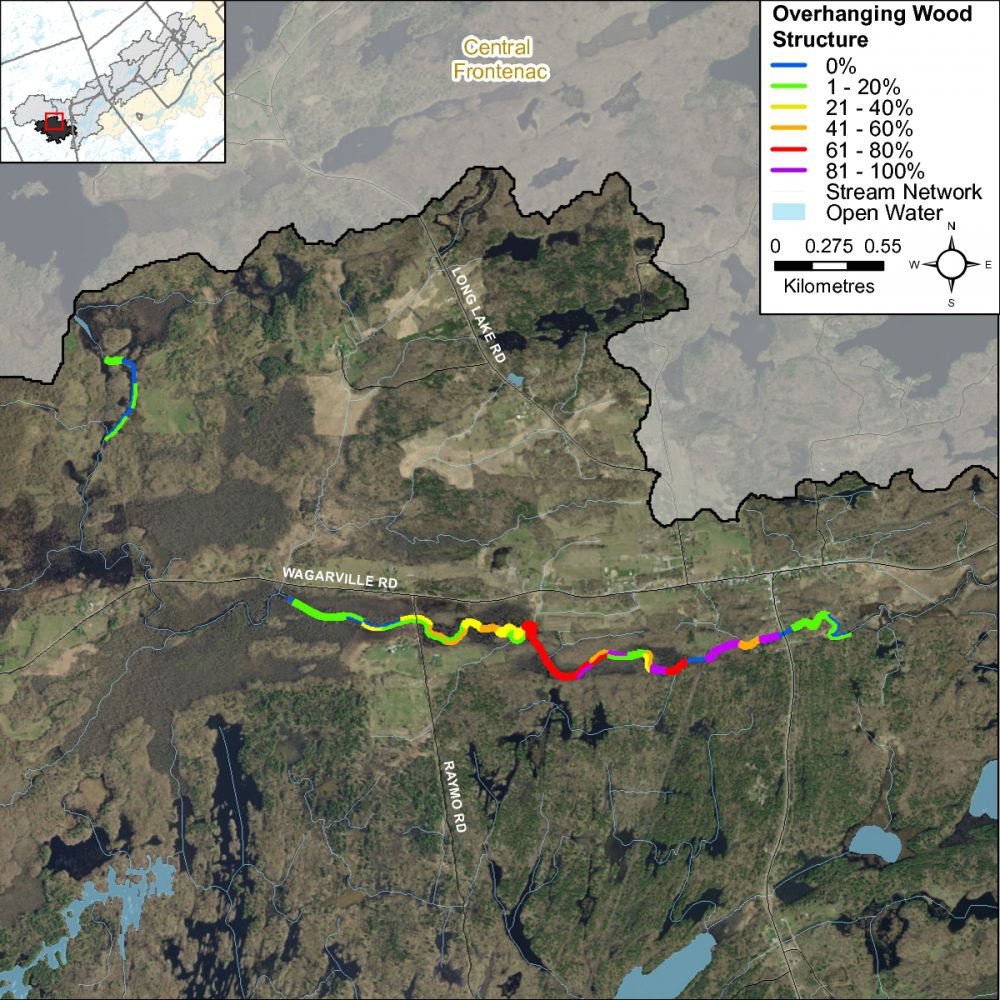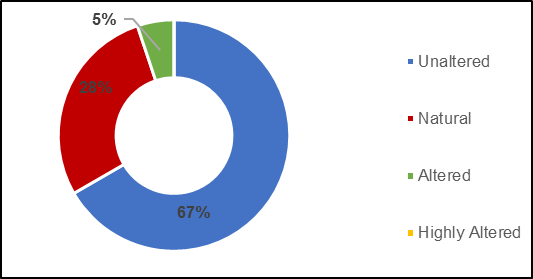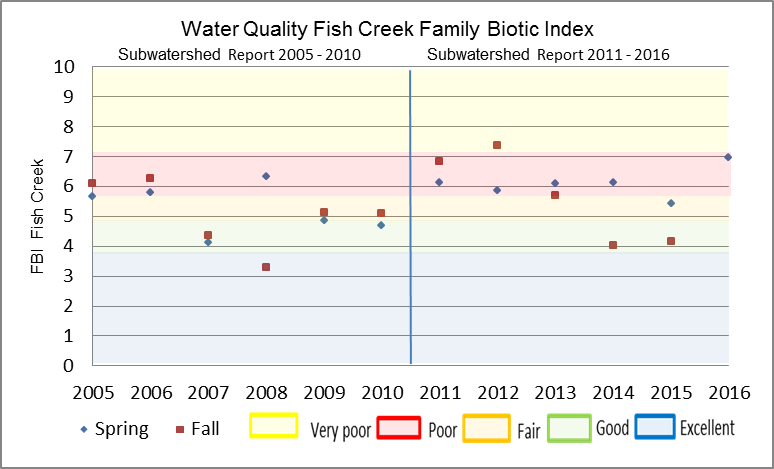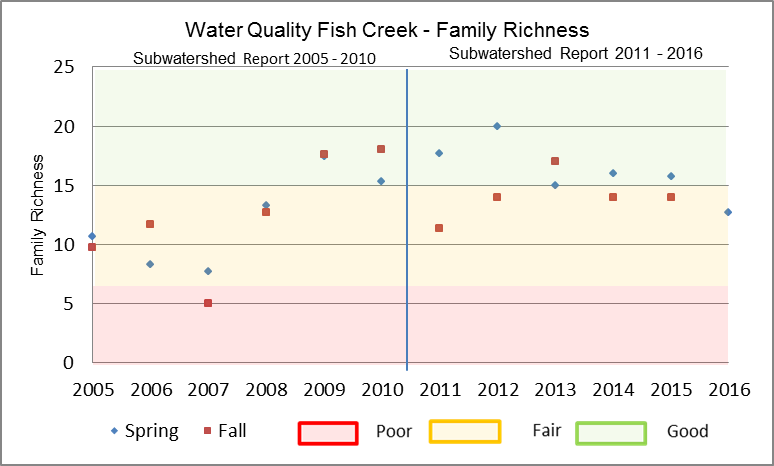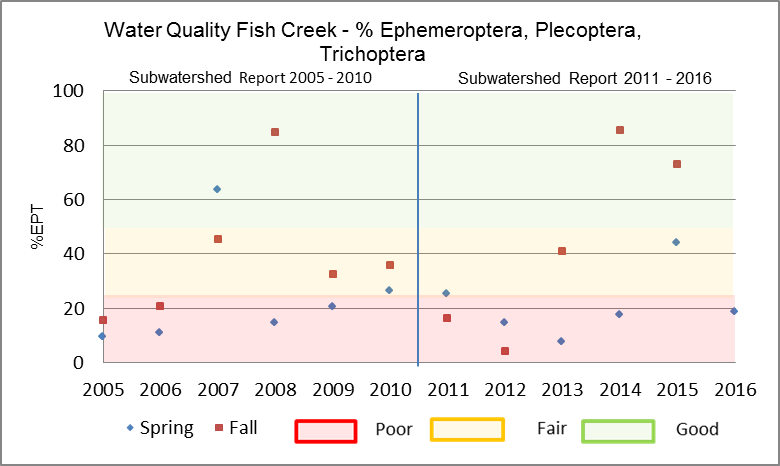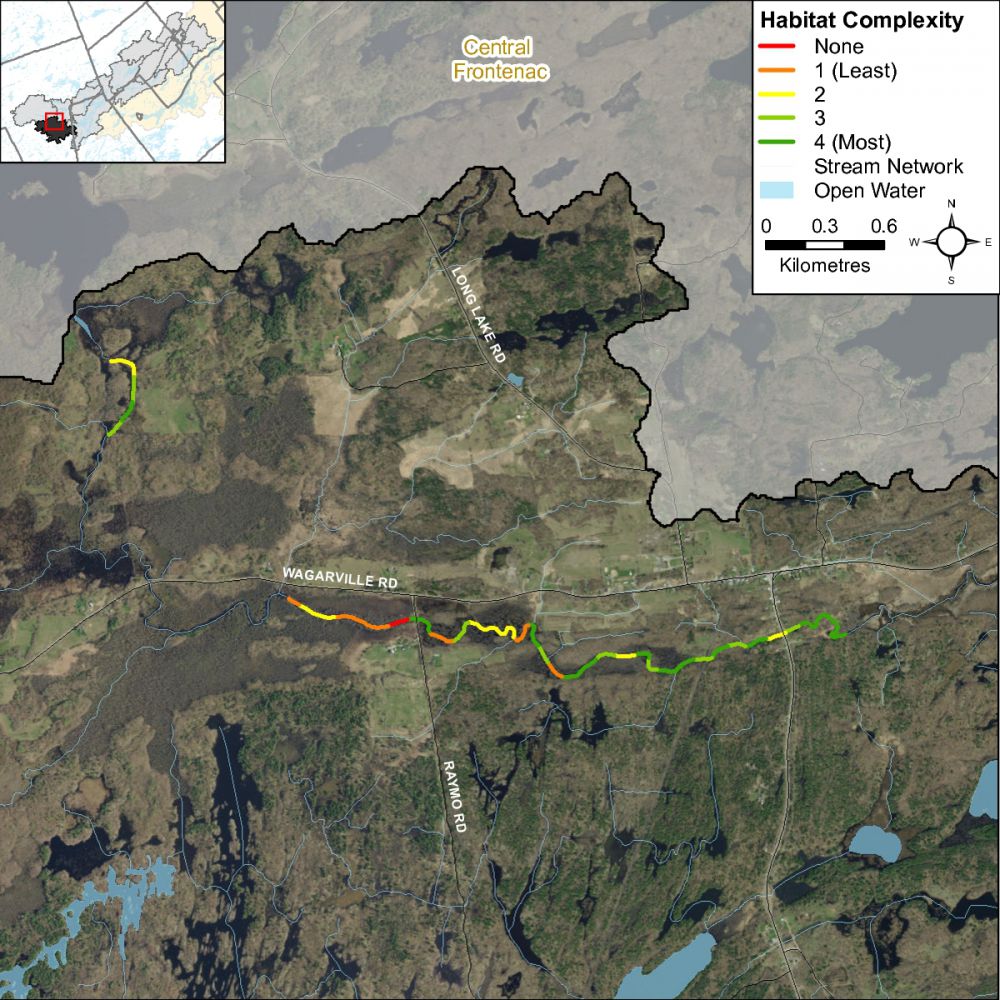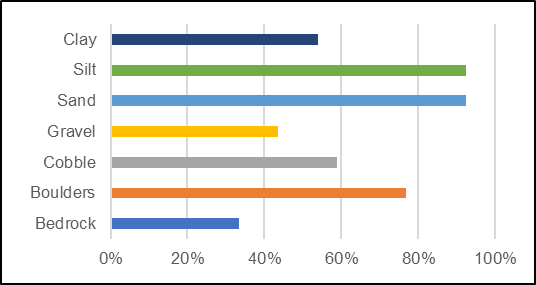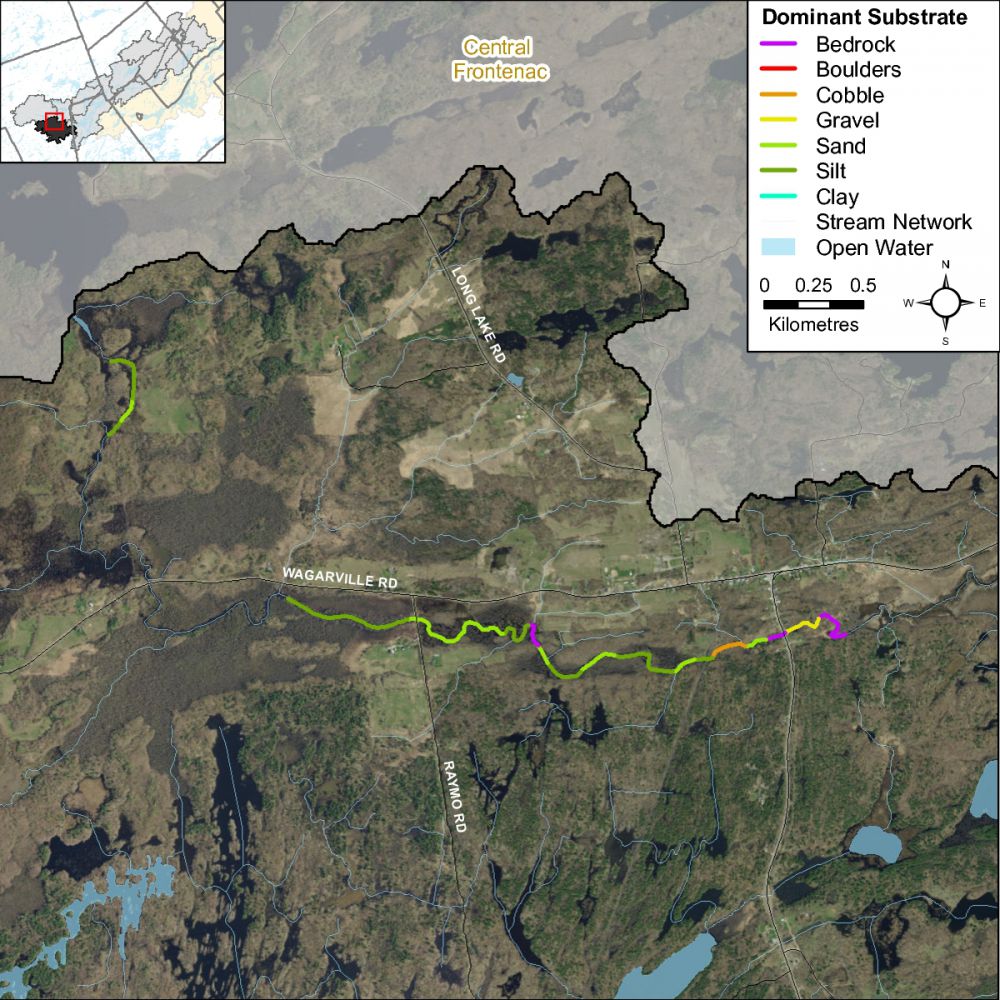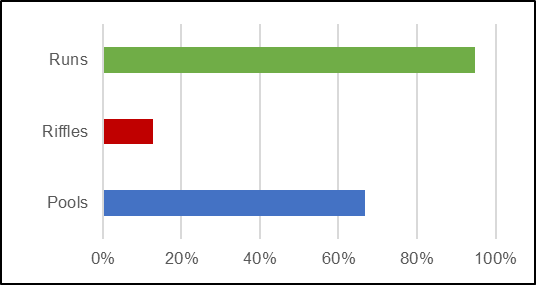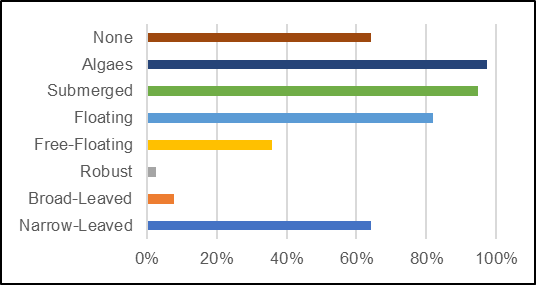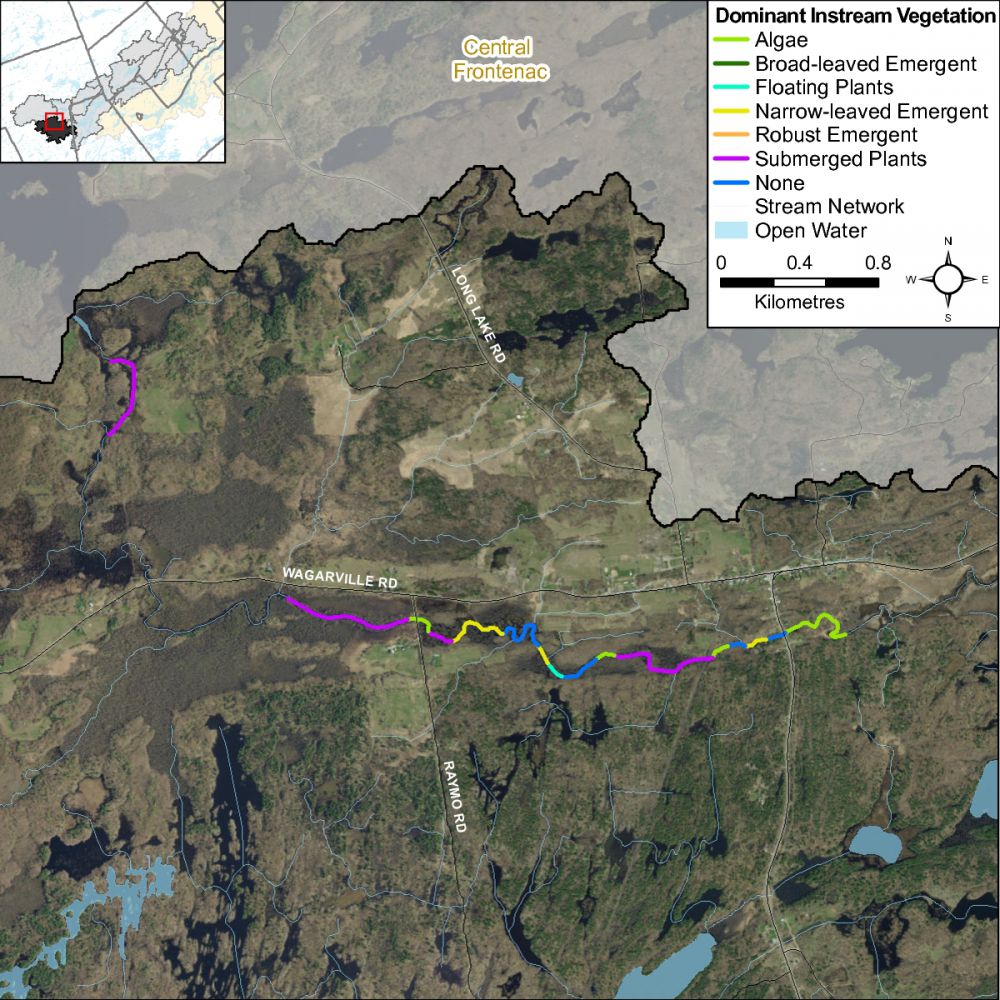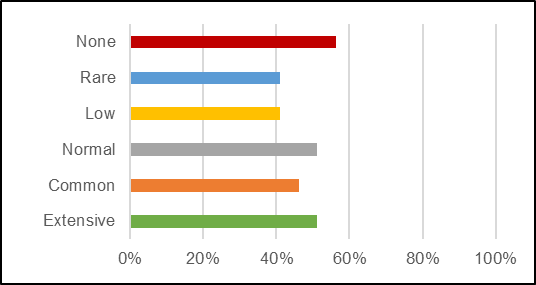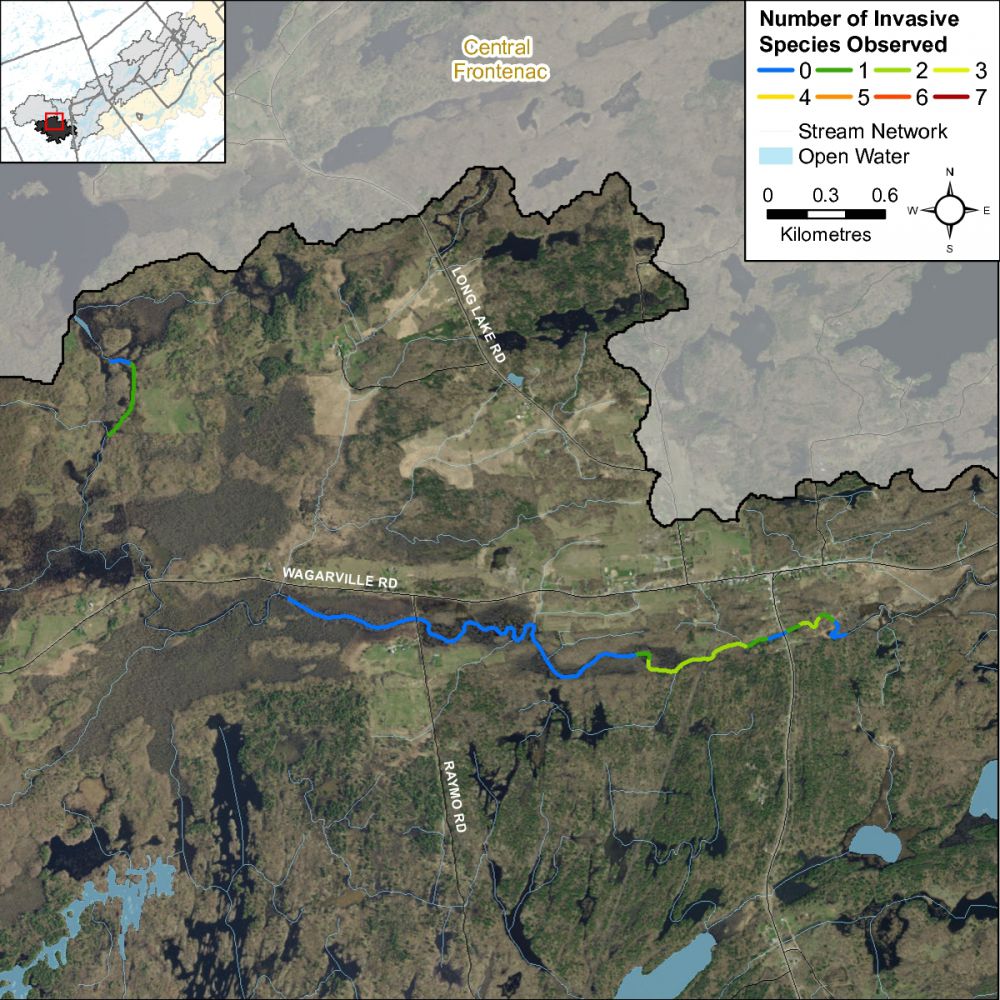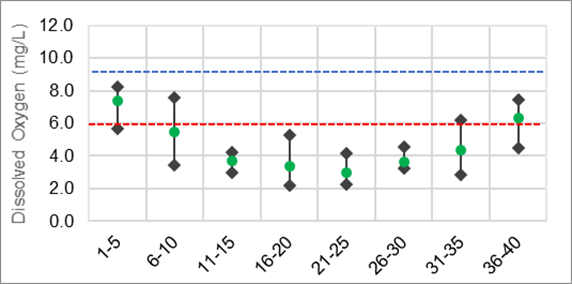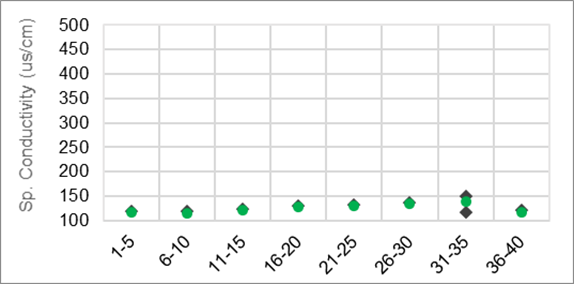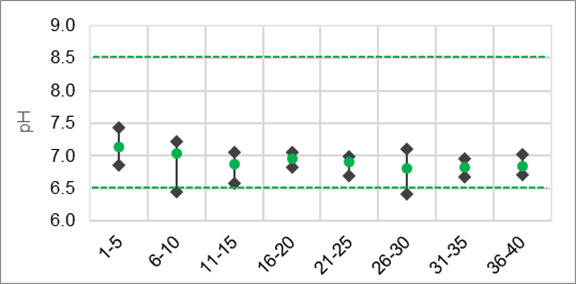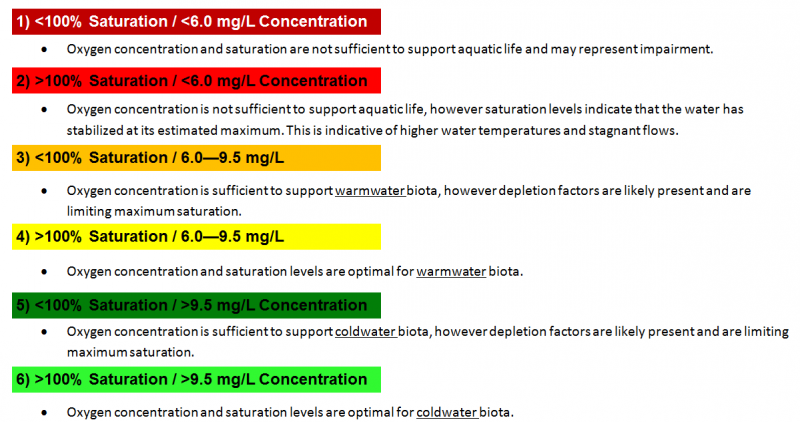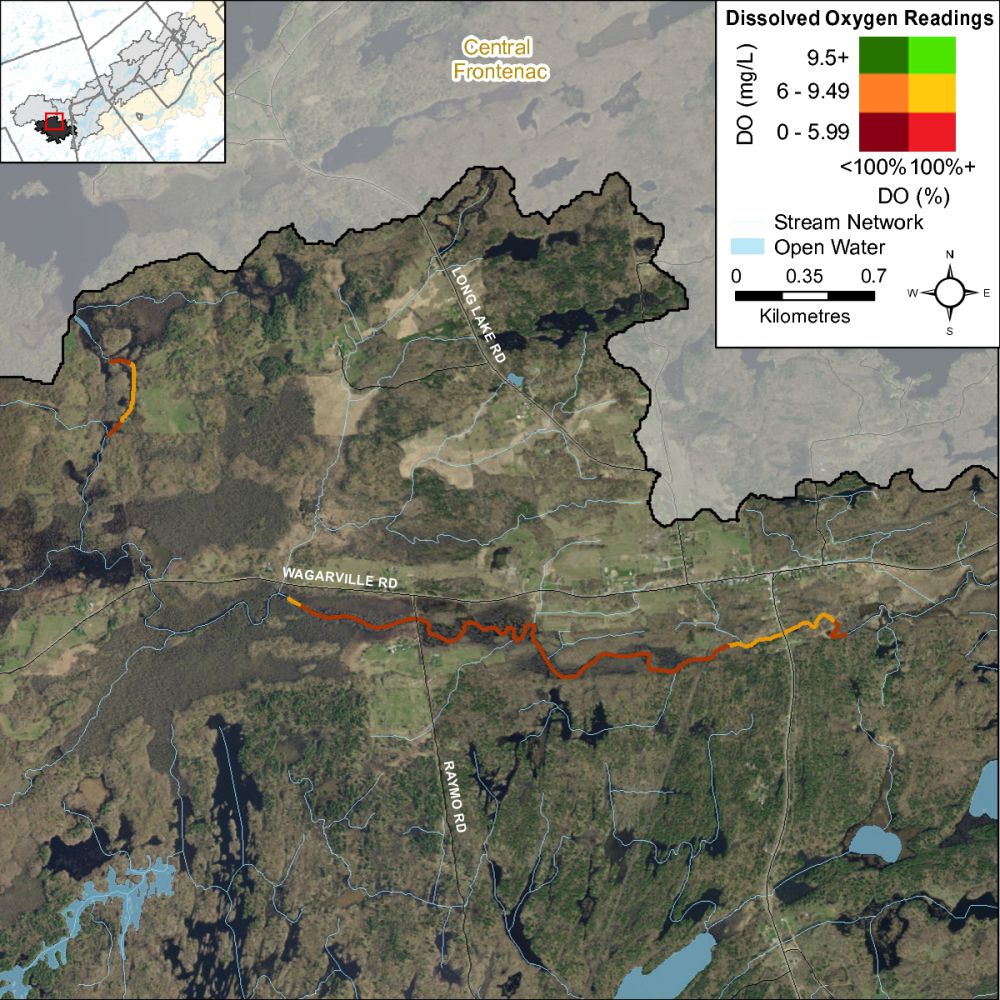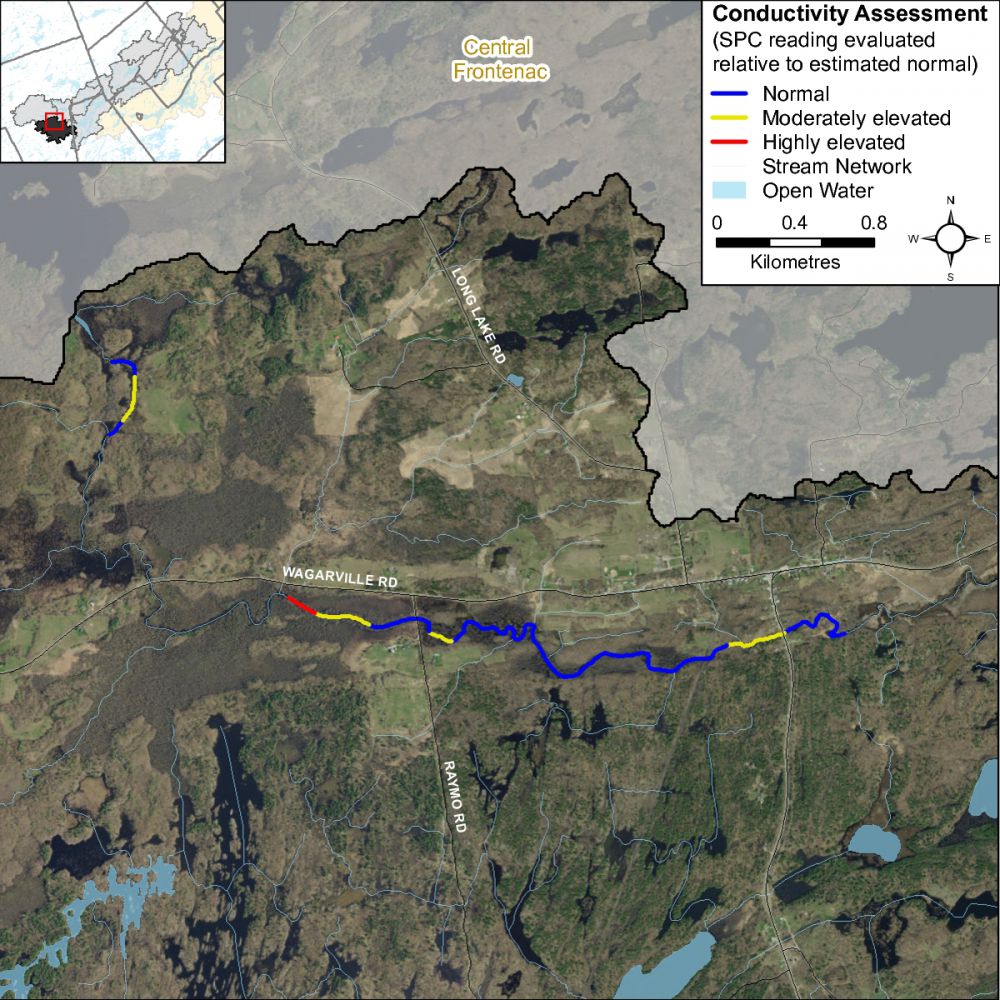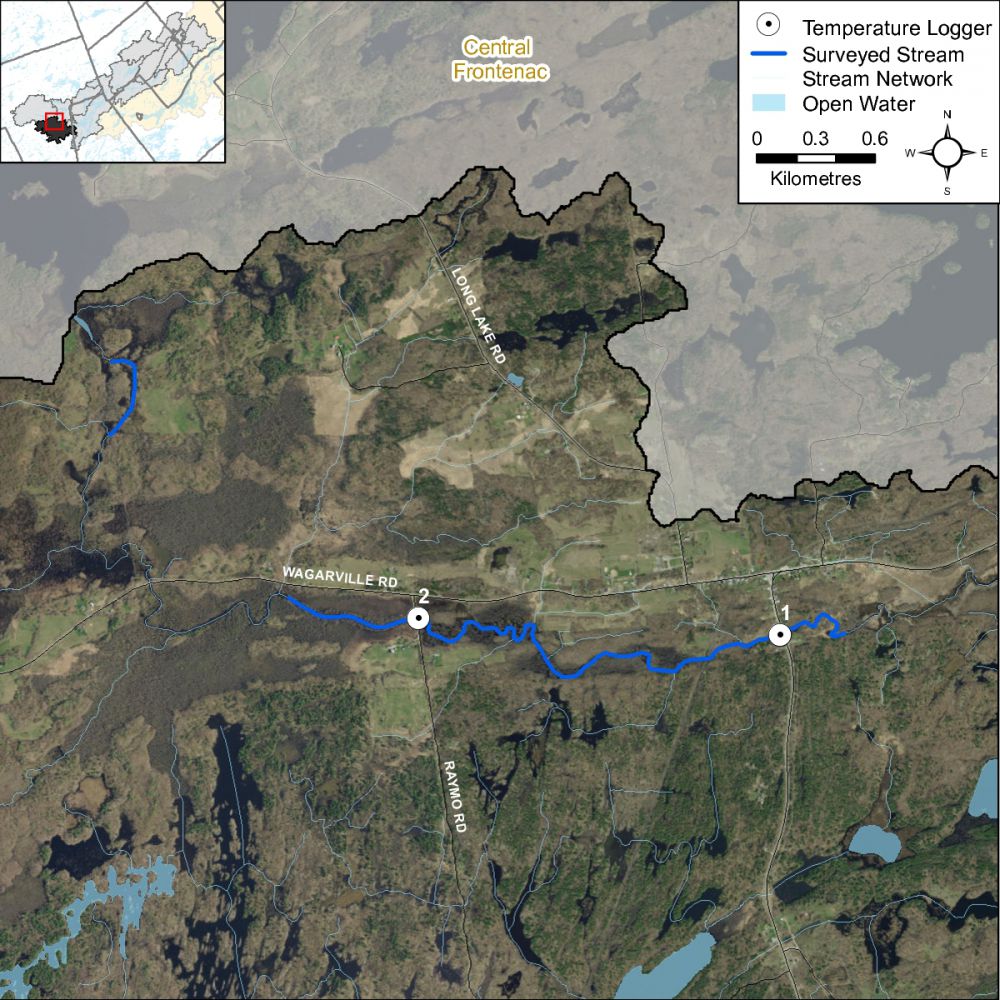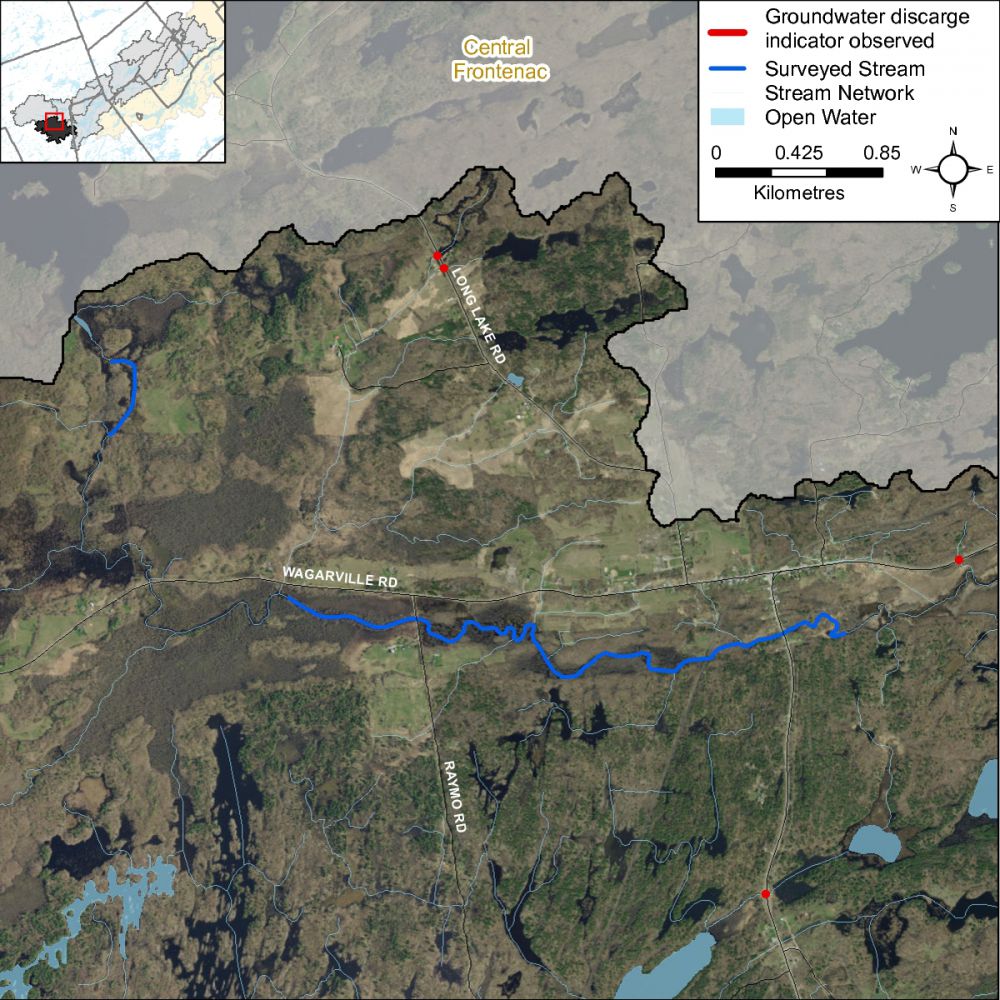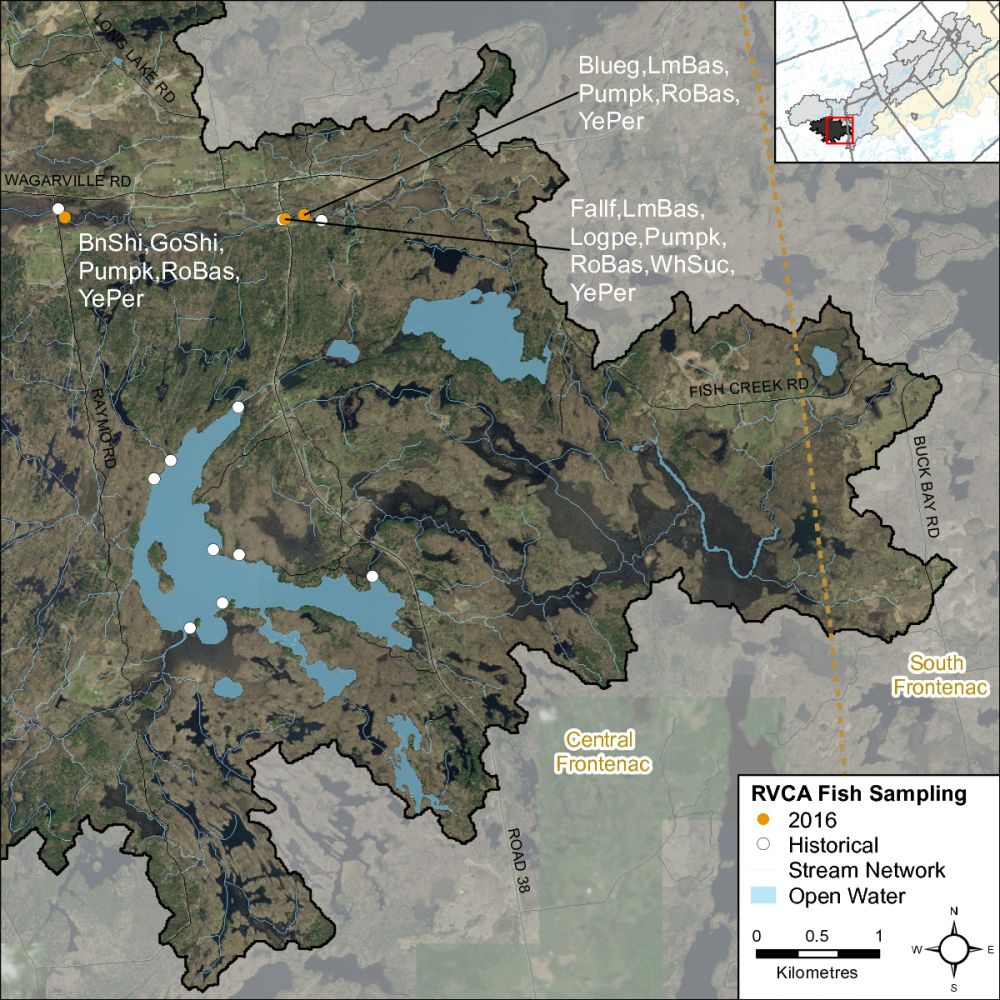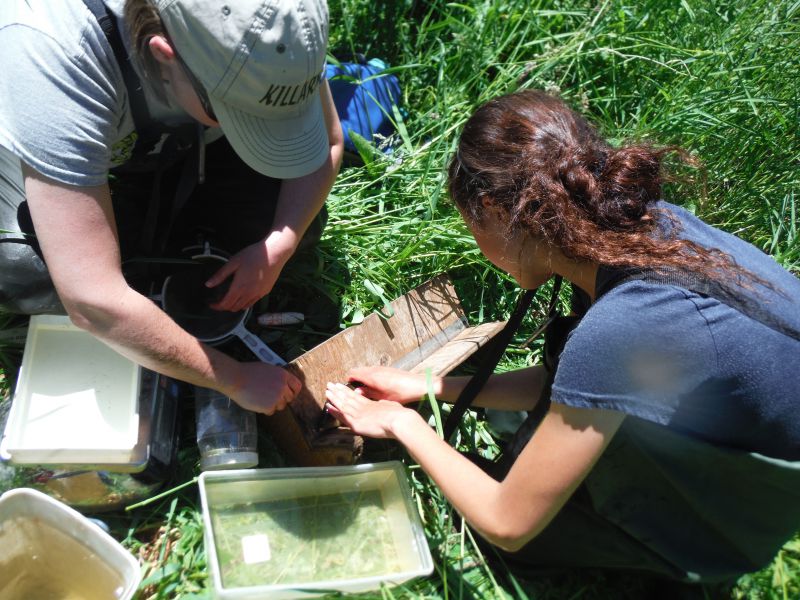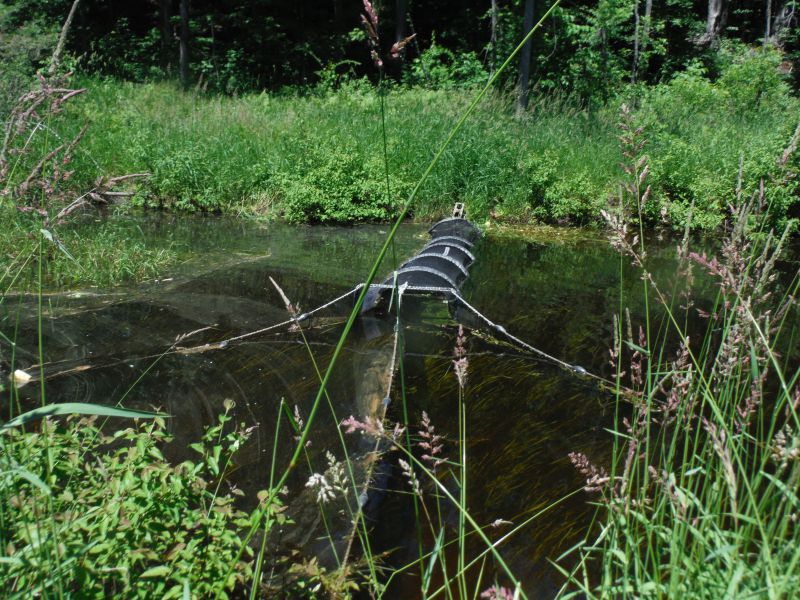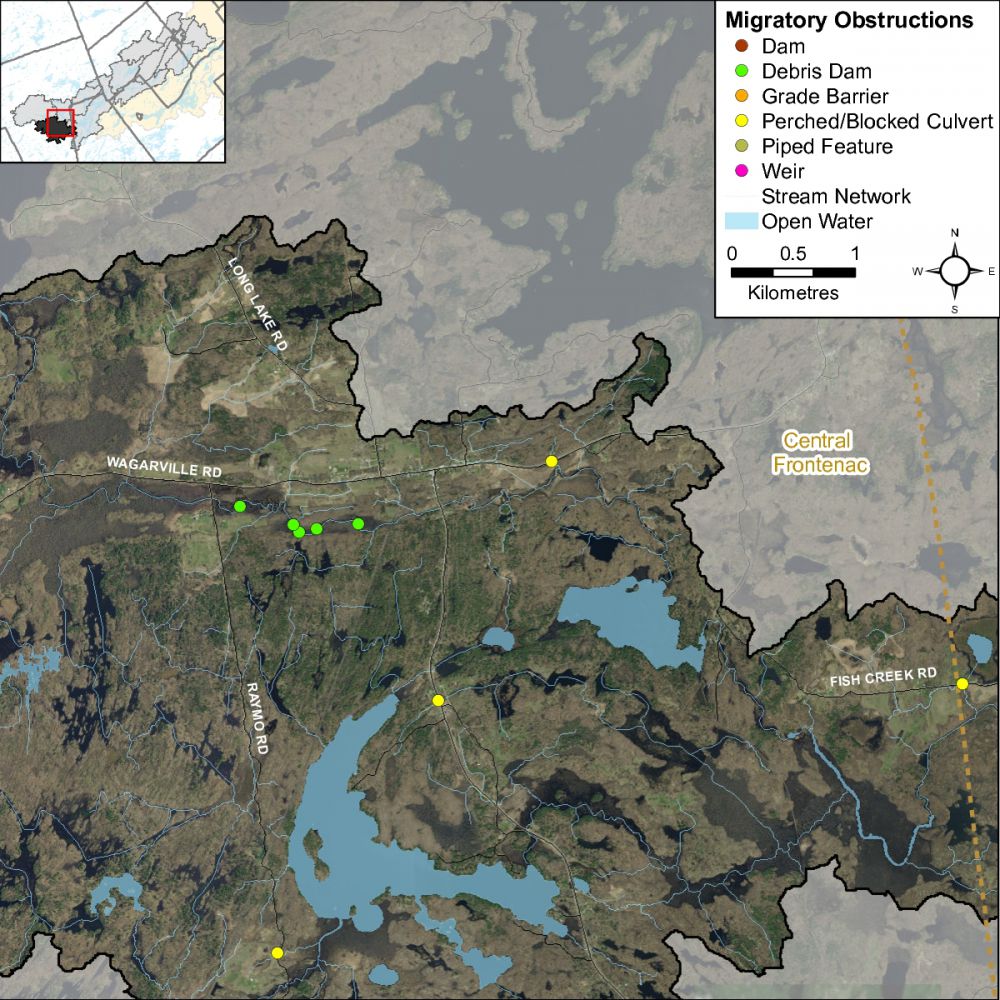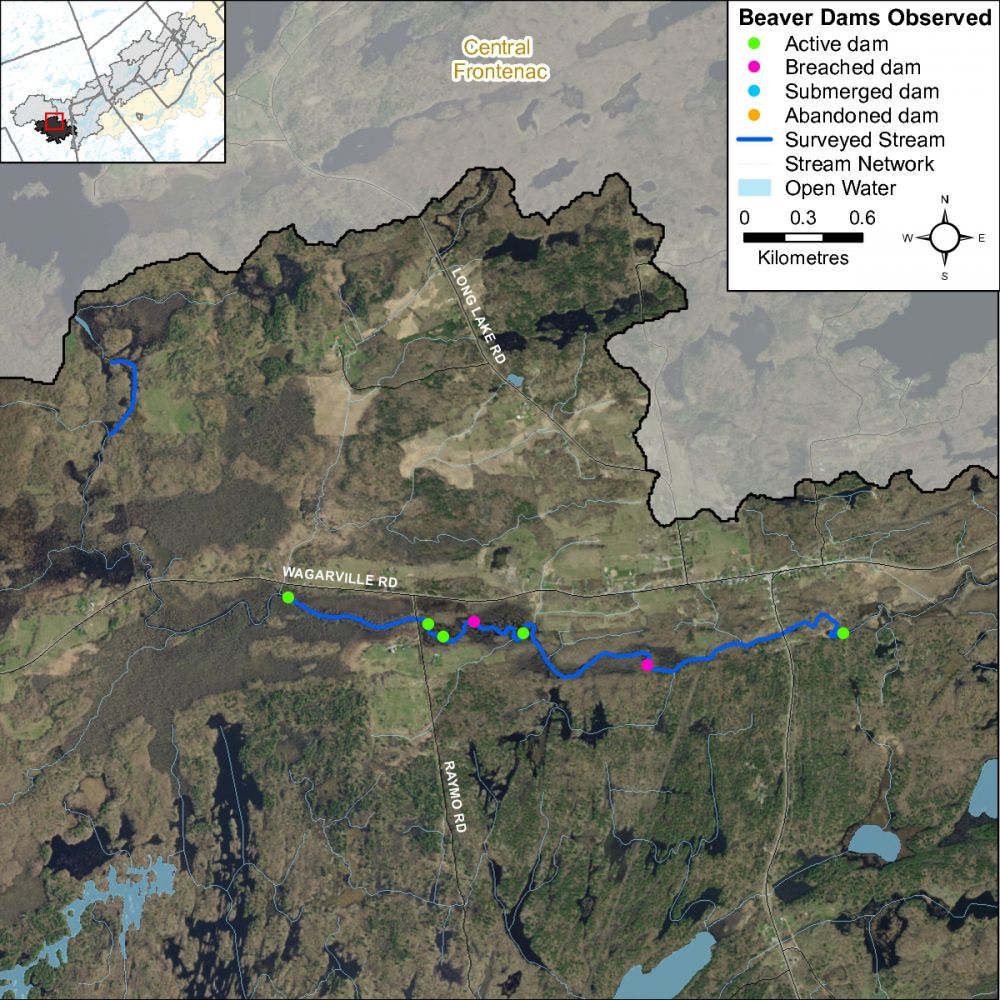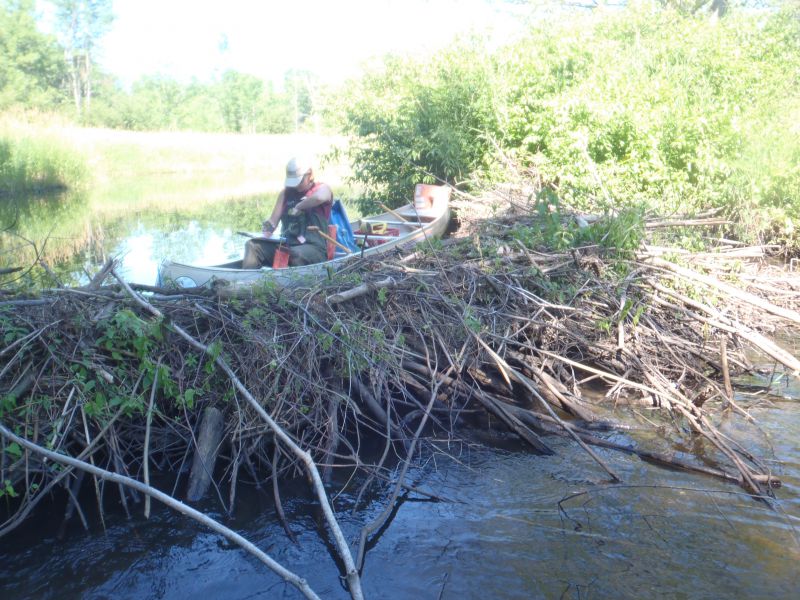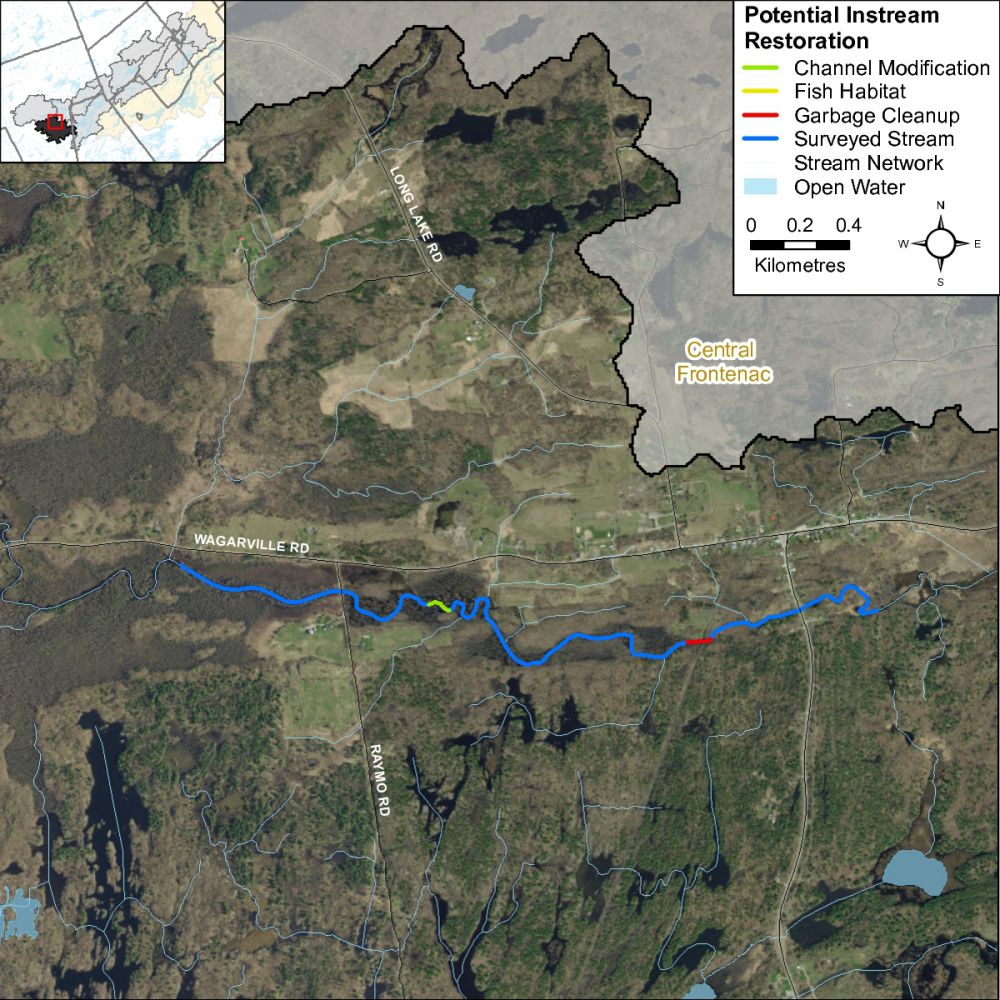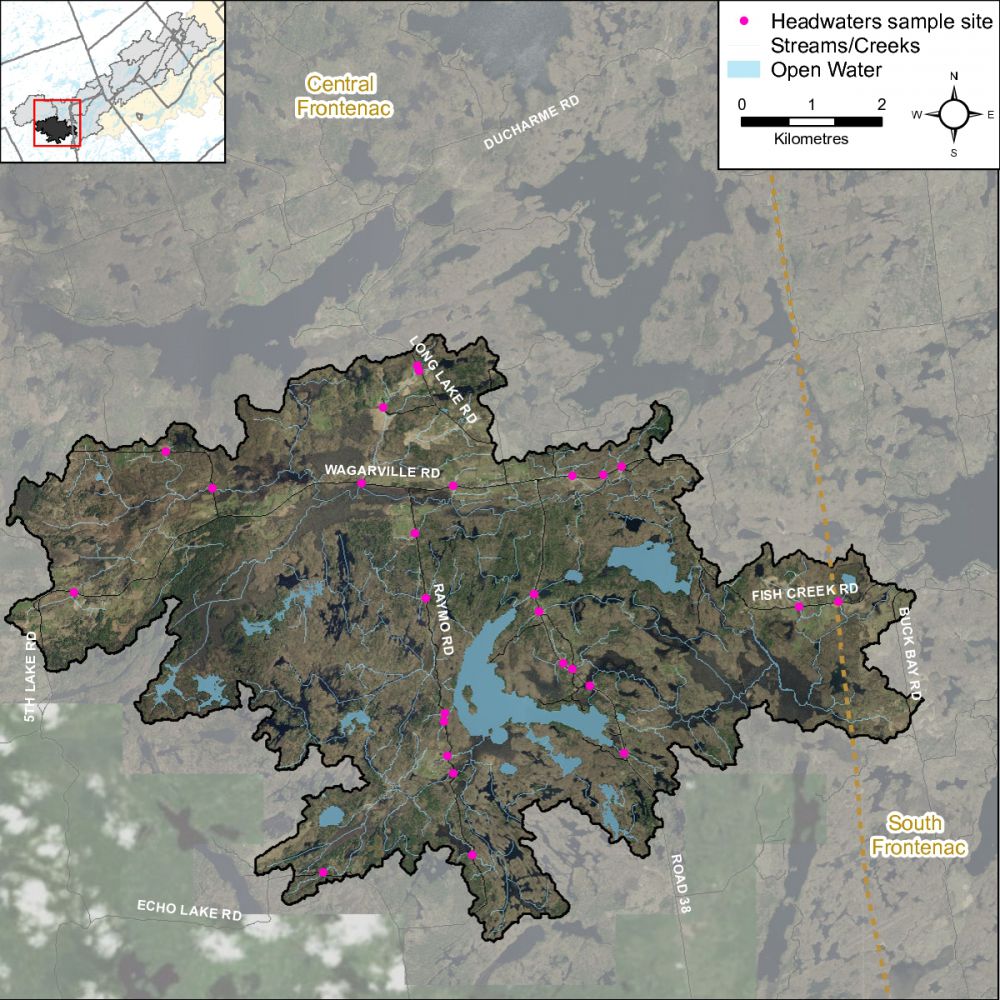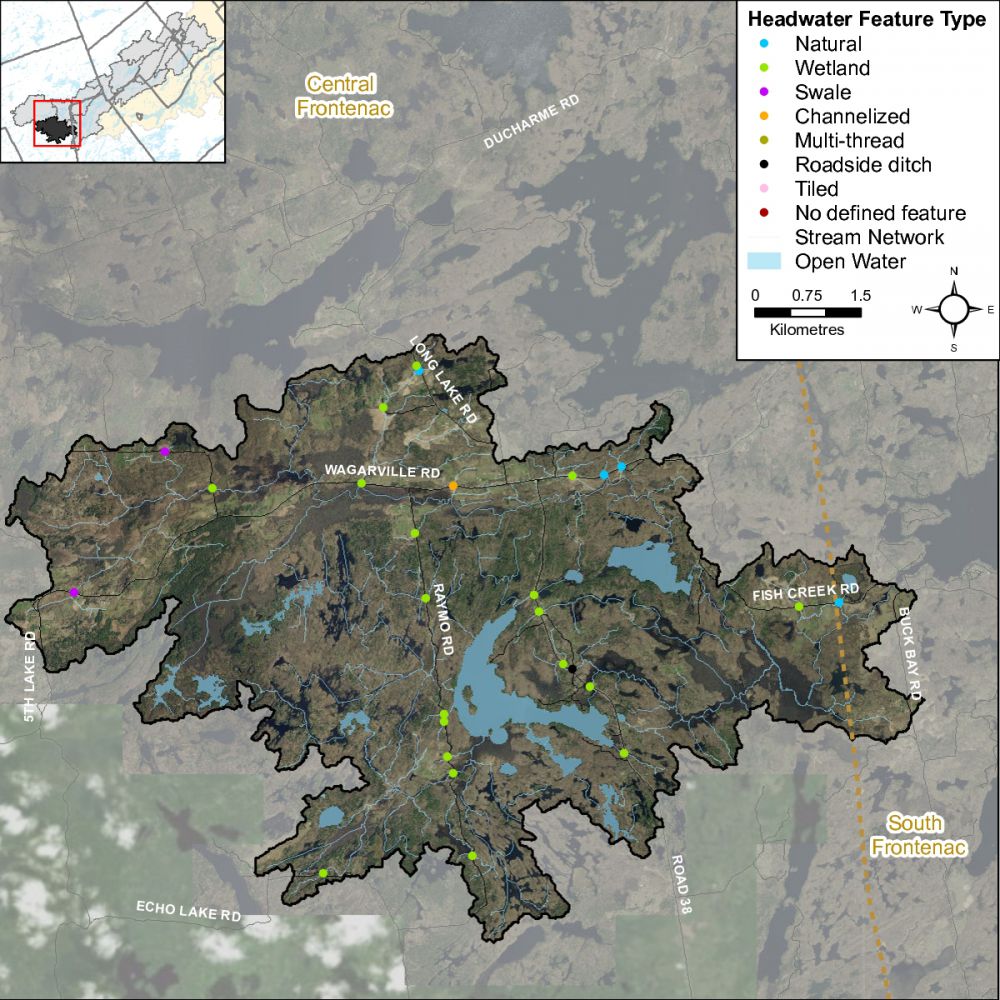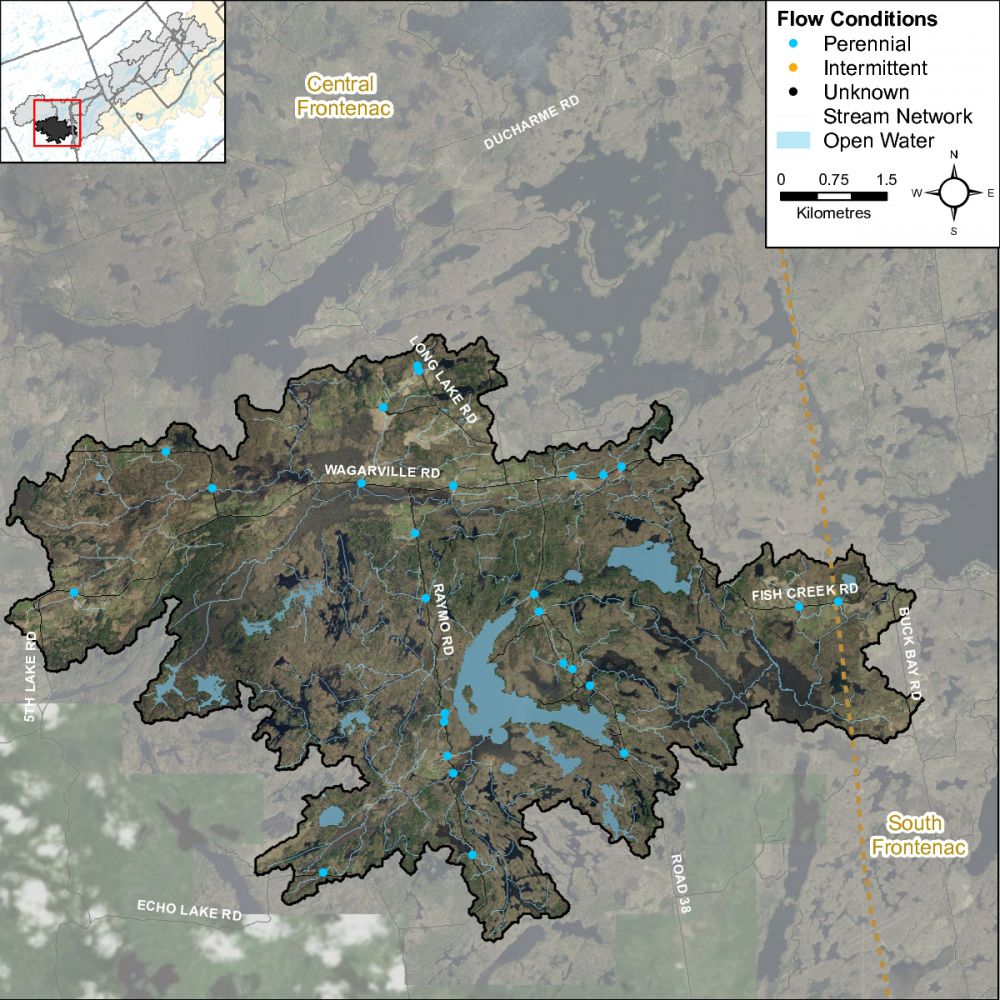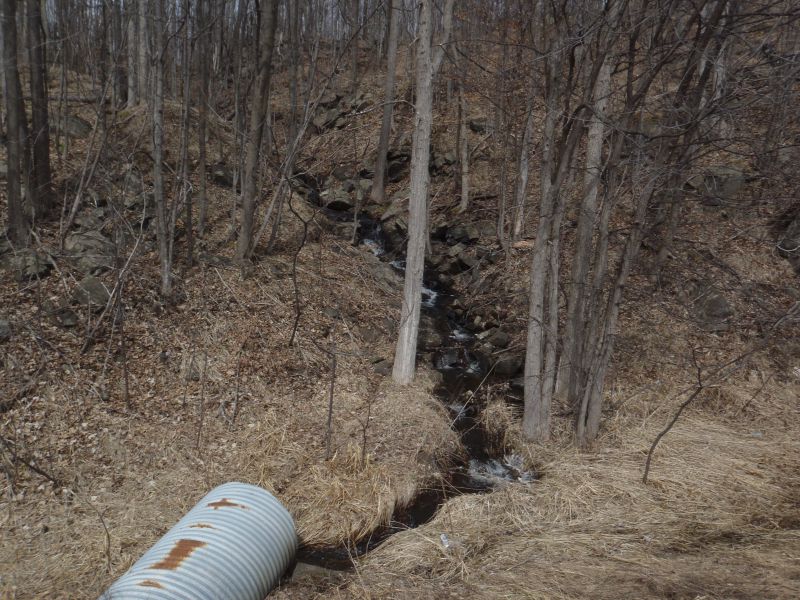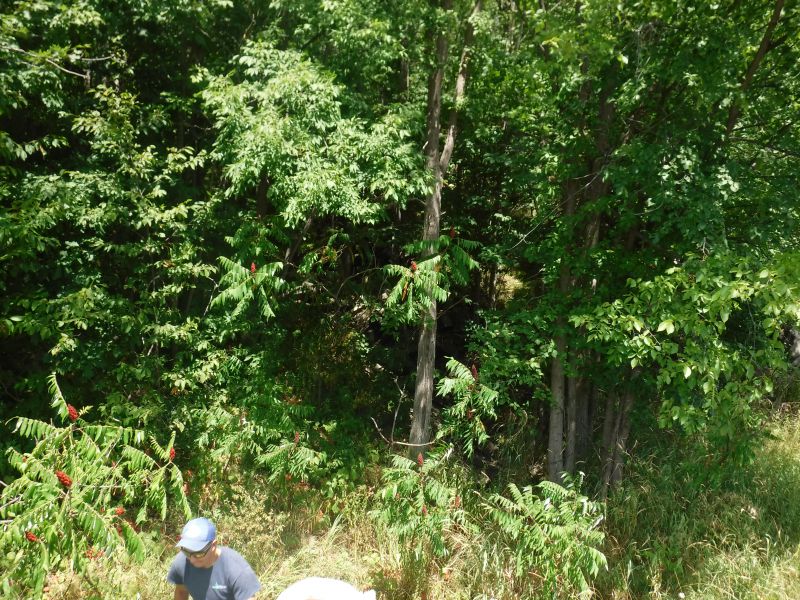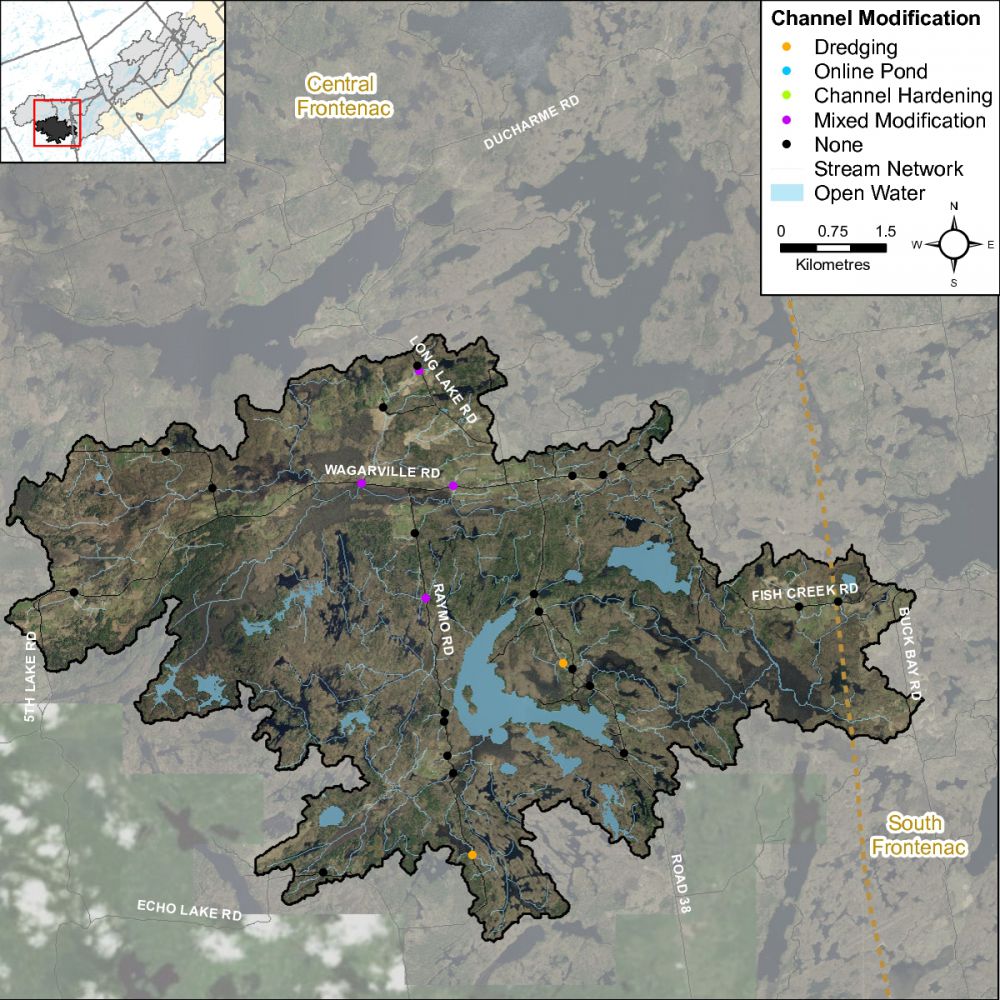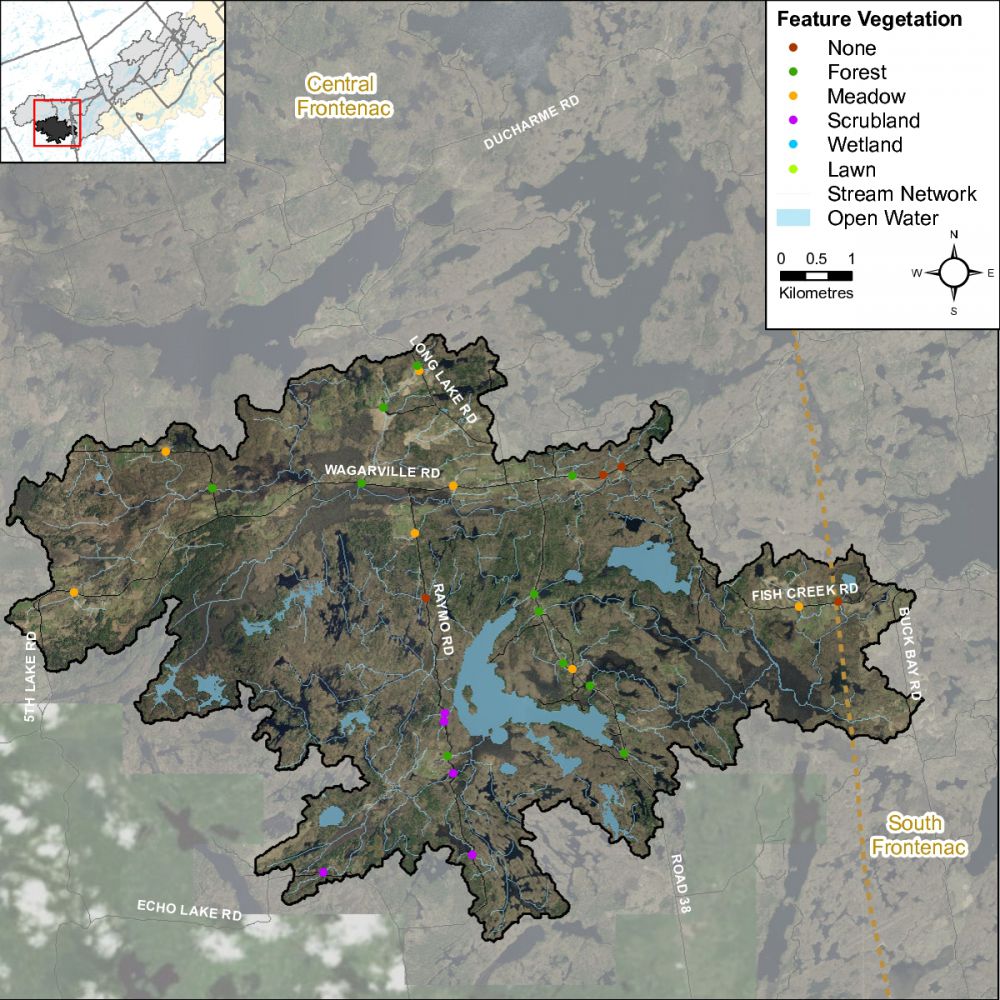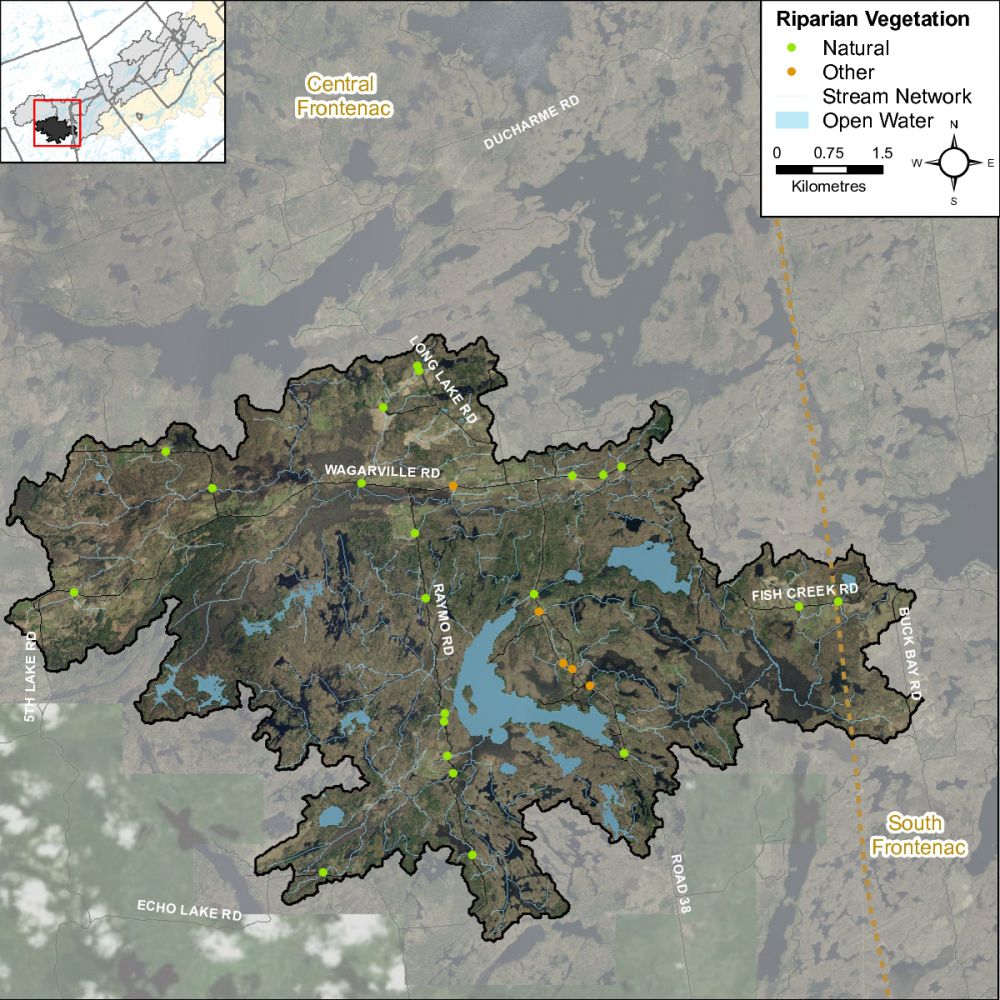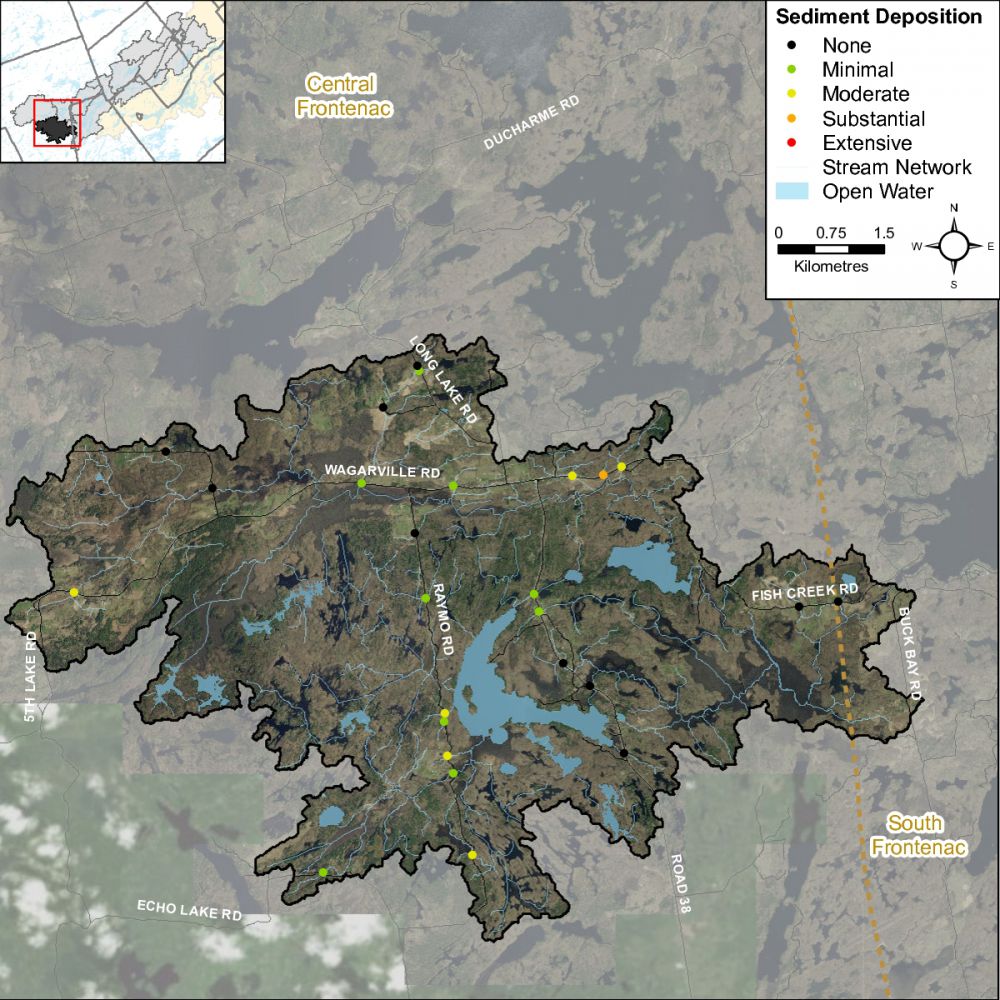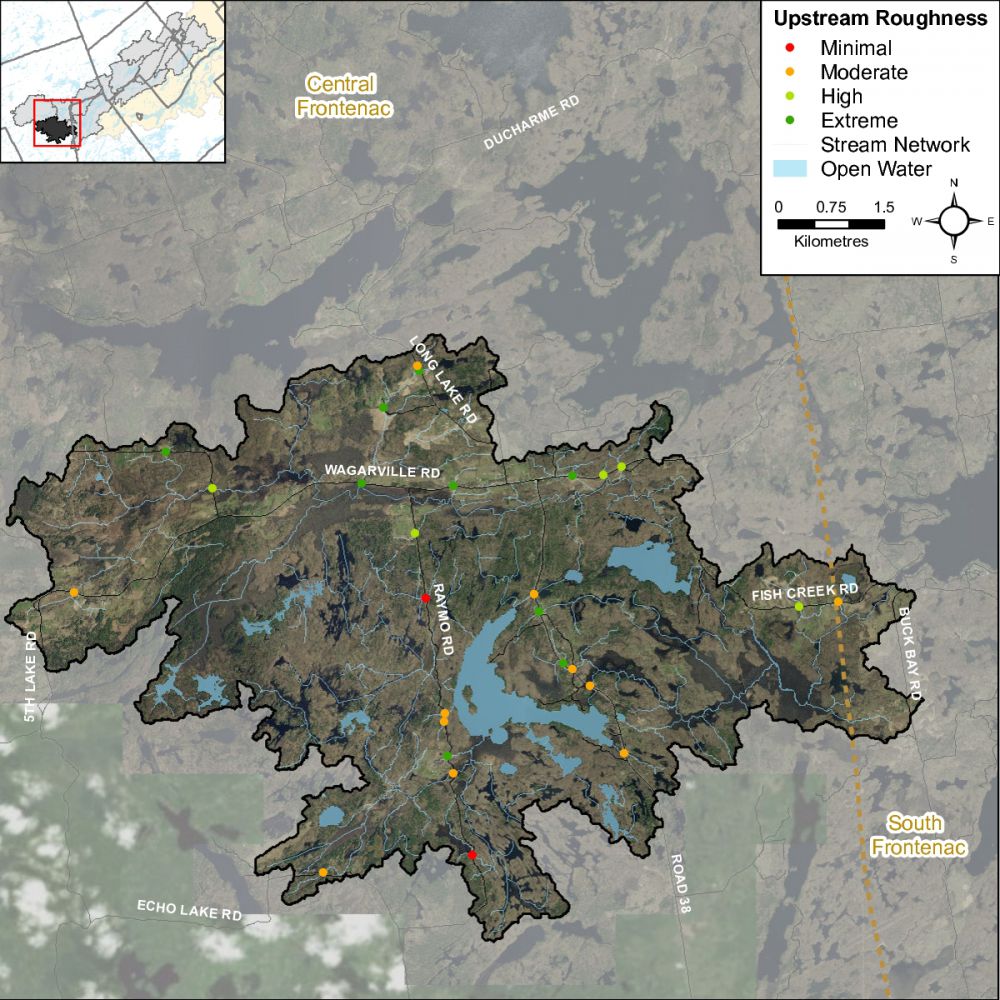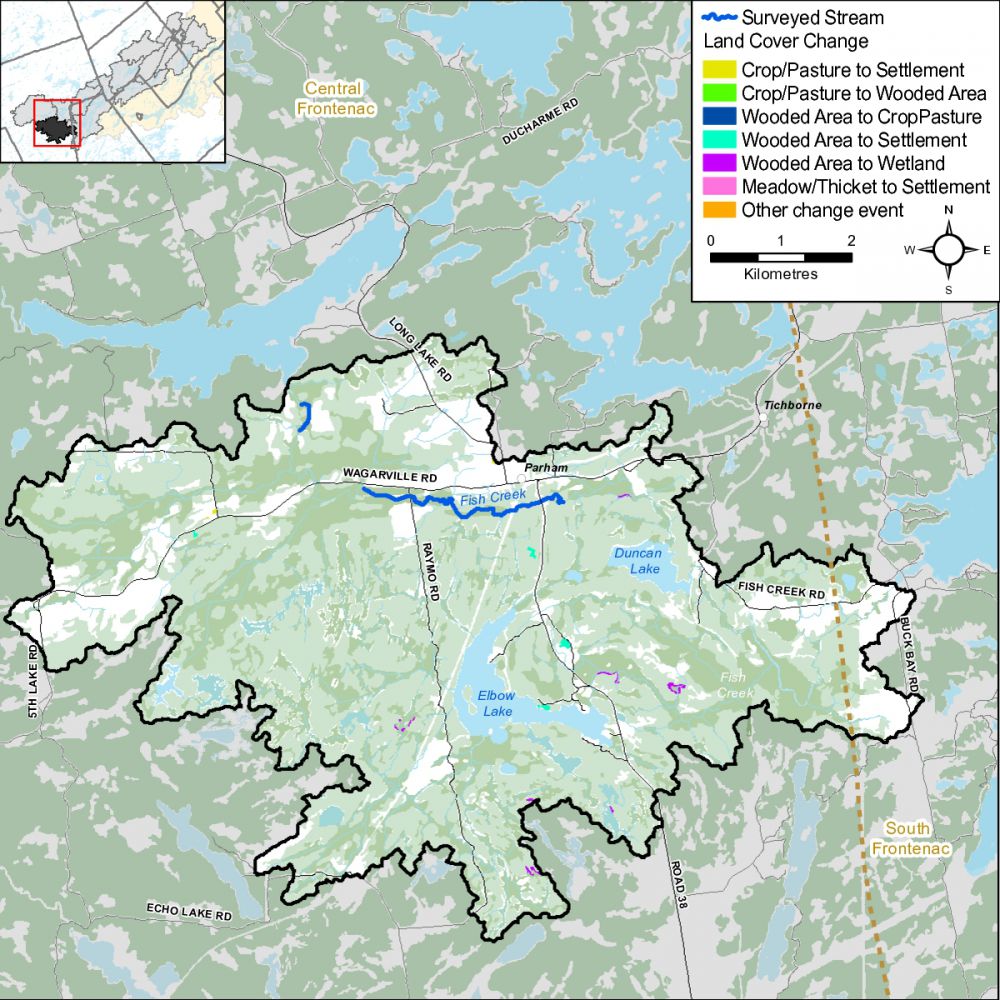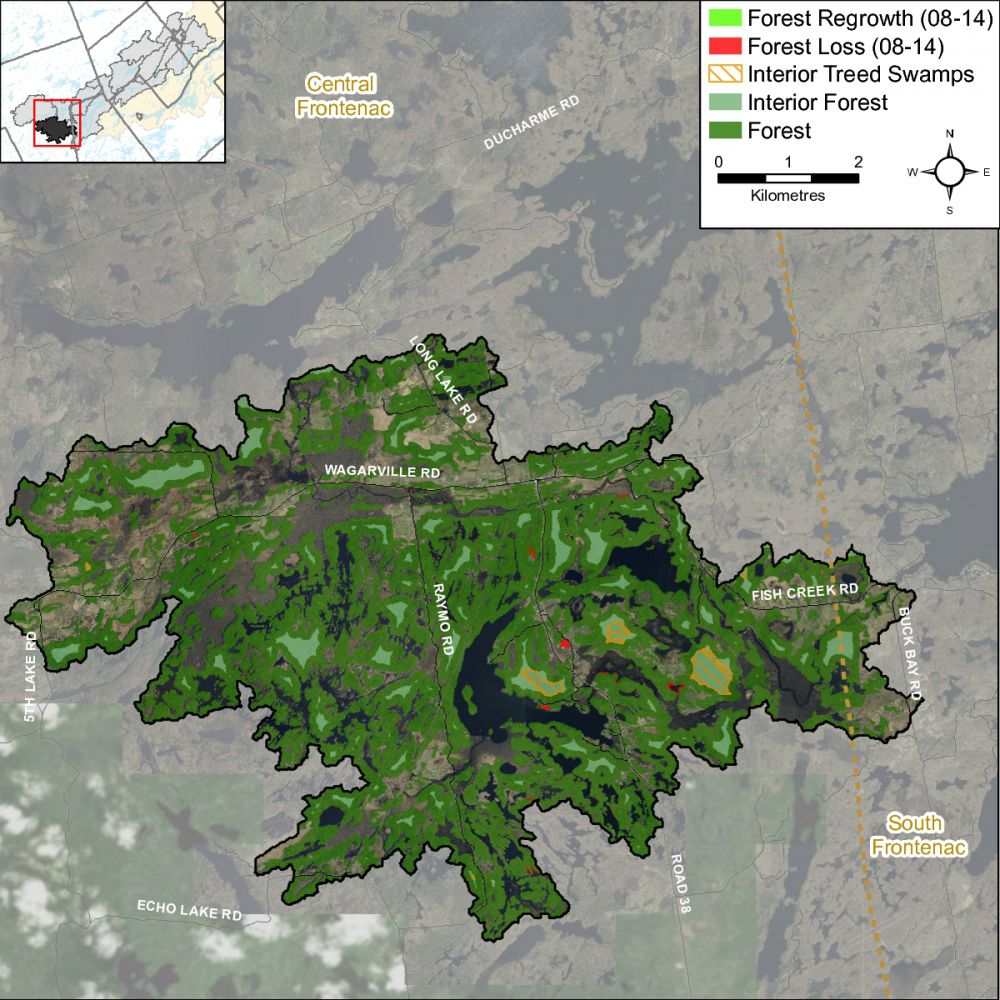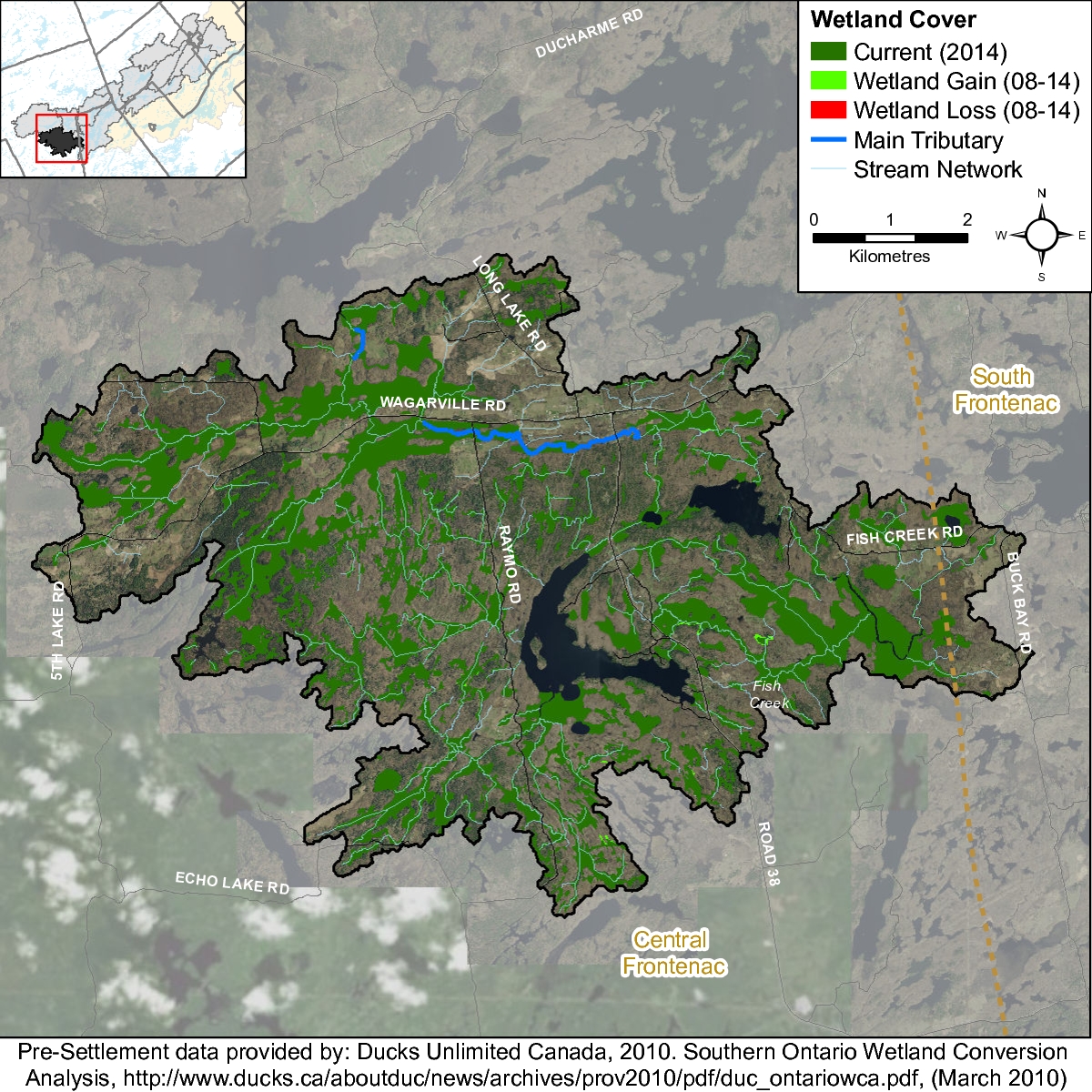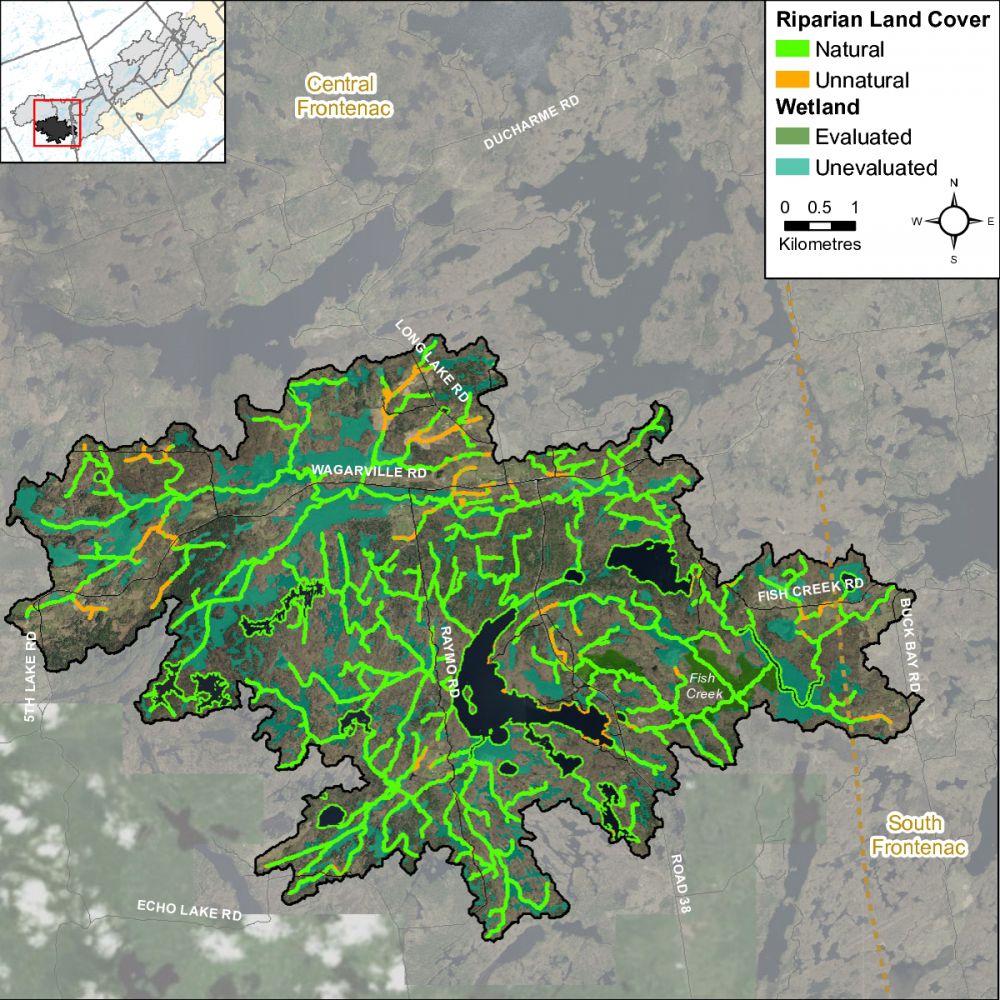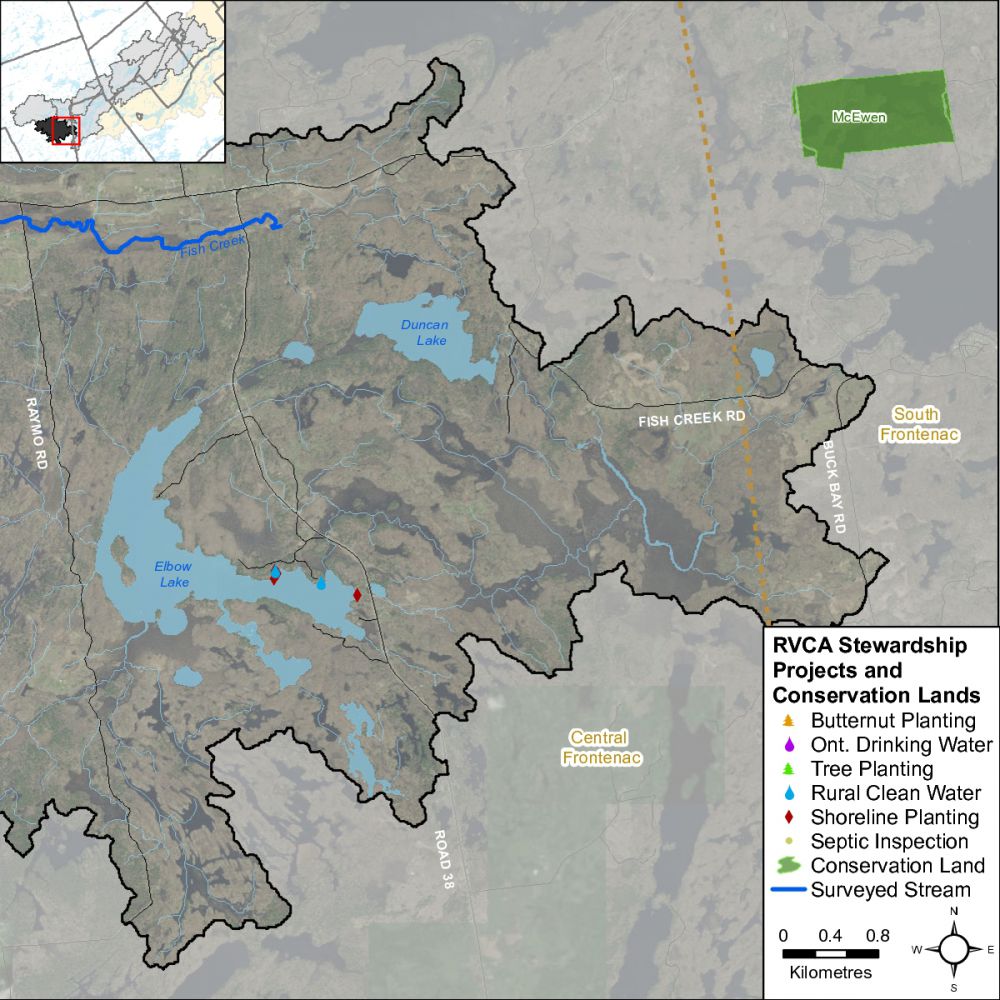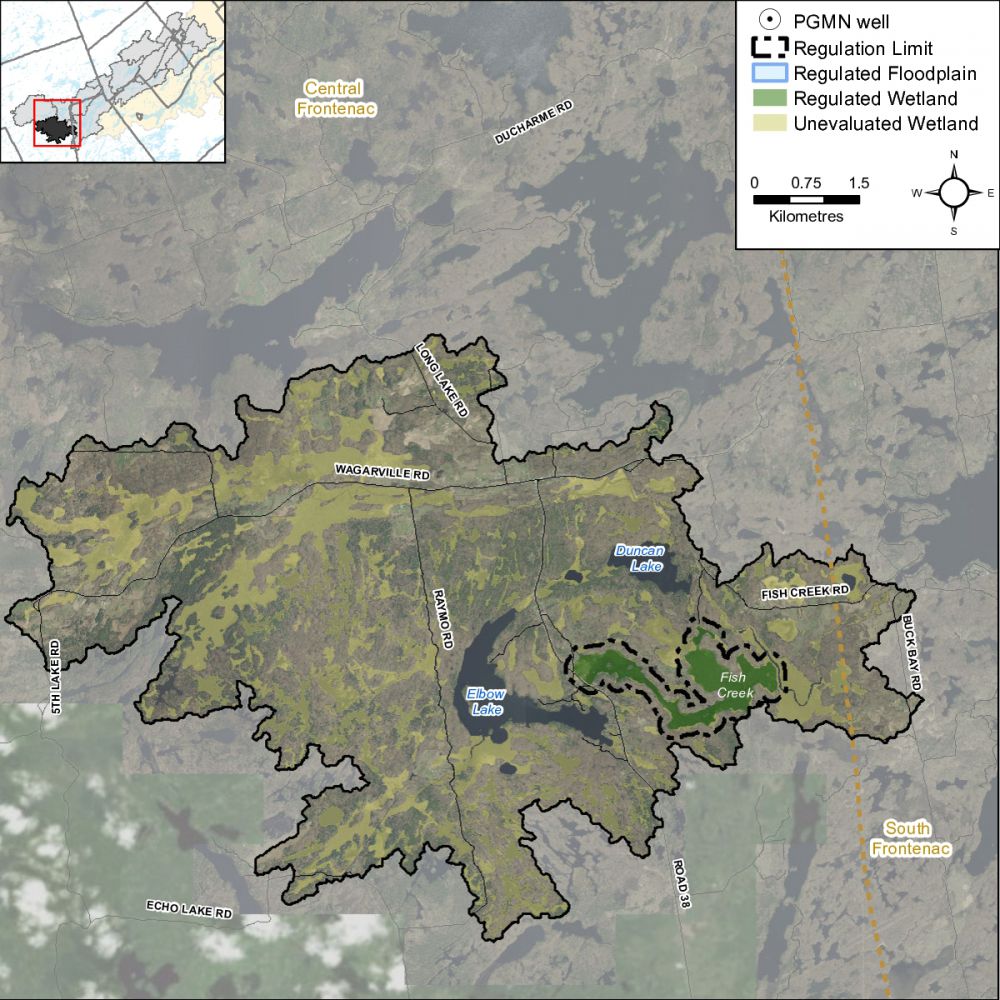3.0 Elbow Lake Catchment: Riparian Conditions
The Stream Characterization Program evaluated 3.9 km of Fish Creek in 2016. A total of 39 stream survey assessments were completed in the middle of June and July.
During the summer and fall of 2016, the Rideau Valley watershed experienced periods of severe drought. Precipitation levels were measured at less than 40 percent of the long-term average, as the water supply was unable to meet local demand. The lack of rainfall affected the success and function of farm crops, municipal and private wells, lawns and gardens, navigation and ultimately the health of our lakes, rivers and streams.
Low water conditions were readily observed throughout the watershed, as many of the streams were highly fragmented or completely dry. Aquatic species such as amphibians, fish and macroinvertebrates were affected, as suitable habitat may have been limited. Fragmentation of habitat was observed in sections along Fish Creek during drought conditions in 2016.
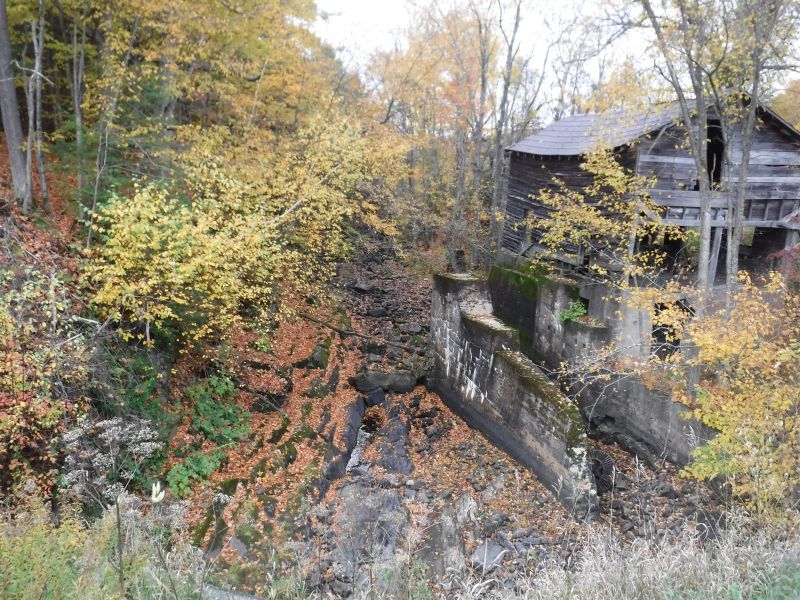
Fish Creek at County Road 38 in Parham during the drought in the Fall of 2016
3.1 Fish Creek Overbank Zone
3.1.1 Riparian Buffer Land Cover Evaluation
The quality of the riparian area increases with the width, complexity and linear extent of its vegetation along a stream or creek. A complex riparian community consists of diverse plant species native to the site, with multiple age-classes providing vertical structural diversity along a watercourse.
Here is a list of watershed benefits from a healthy riparian buffer zone:
- Reduces the amount of pollutants that reach the stream from surface runoff
- Helps reduce and mitigates erosion
- Provides a microclimate that is cooler during the summer months providing cooler water for aquatic organisms
- Provides large wood structure from fallen trees and limbs that form instream cover, create pools, stabilize the streambed, and provide habitat for aquatic organisms
- Provides organic material for stream biota that, among other functions, is the base of the food chain in lower order streams
- Provides habitat for terrestrial insects that drop in the stream and become food for fish and travel corridors for other terrestrial animals
- Dissipates energy during flood events
- Often provides the only refuge areas for fish during out-of-bank flows (behind trees, stumps, and logs)
Figure 21 demonstrates the buffer conditions of the left and right banks separately. Fish Creek had a buffer of greater than 30 meters along 92 percent of the left bank and 83 percent of the right bank.
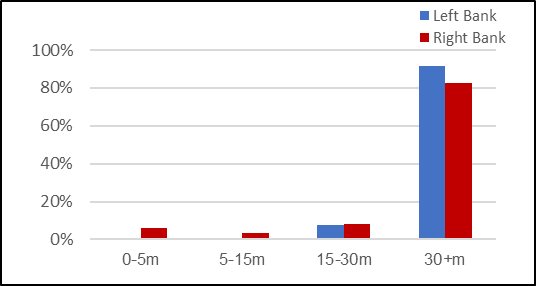
Figure 21 Riparian Buffer Evaluation along Fish Creek
3.1.2 Riparian Buffer Alterations
Alterations within the riparian buffer were assessed within three distinct shoreline zones (0-5m, 5-15m, 15-30m), and evaluated based on the dominant vegetative community and/or land cover type (Figure 22). The riparian buffer zone along Fish Creek was found to be dominated by forest, scrubland and wetland conditions. There were several short areas that had altered riparian zone conditions along the watercourse.
Figure 22 Riparian buffer alterations along Fish Creek
3.1.3 Adjacent Land Use
The RVCA’s Stream Characterization Program identifies nine different land uses along Fish Creek (Figure 23). Surrounding land use is considered from the beginning to end of the survey section (100m) and up to 100m on each side of the creek. Land use outside of this area is not considered for the surveys but is nonetheless part of the subwatershed and will influence the creek. Forest habitat was dominant at 100 percent of sections surveyed; scrubland was found at 62% of sections, 44 percent was classified as meadow habitat, while wetland habitat was observed in the adjacent lands along Fish Creek at 13 percent of the surveyed sections. The remaining land use consisted of active agriculture, pasture, abandoned agriculture, residential and infrastructure in the form of road crossings.
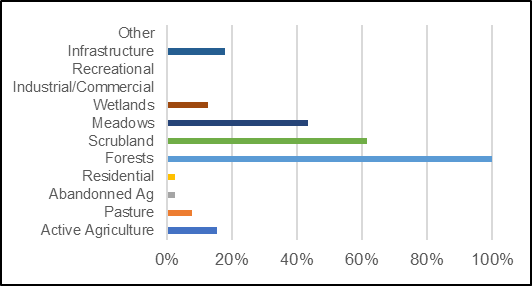
Figure 23 Land Use along Fish Creek
3.2 Fish Creek Shoreline Zone
3.2.1 Instream Erosion
Stream erosion is the process by which water erodes and transports sediments, resulting in dynamic flows and diverse habitat conditions. Excessive erosion can result in drastic environmental changes, as habitat conditions, water quality and aquatic life are all negatively affected. Bank stability was assessed as the overall extent of each section with “unstable” shoreline conditions. These conditions are defined by the presence of significant exposed soils/roots, minimal bank vegetation, severe undercutting, slumping or scour and potential failed erosion measures. The majority of Fish Creek had low levels of erosion observed along the surveyed sections with two reaches having moderate levels of erosion in the middle reach (Fig.24).
Figure 24 Erosion levels along Fish Creek
3.2.2 Undercut Stream Banks
Stream bank undercuts can provide excellent cover habitat for aquatic life, however excessive levels can be an indication of unstable shoreline conditions. Bank undercut was assessed as the overall extent of each surveyed section with overhanging bank cover present. Figure 25 shows that Fish Creek had no observed undercut banks along the upper and lower reaches of the system, however there were several sections in the middle reaches with low to moderate levels of undercut banks.
Figure 25 Undercut stream banks along Fish Creek
3.2.3 Stream Shading
Grasses, shrubs and trees all contribute towards shading a stream. Shade is important in moderating stream temperature, contributing to food supply and helping with nutrient reduction within a stream. Stream cover is assessed as the total coverage area in each section that is shaded by overhanging trees/grasses and tree canopy, at greater than 1m above the water surface. Figure 26 shows low levels of stream shading along in the lower and upper reaches of Fish Creek where the channel naturally widens, which is consistent with wetland habitat conditions. There were many sections in the middle reaches, where the channel narrows, that had high to moderate levels of stream shading along the creek.
Figure 26 Stream shading along Fish Creek
3.2.4 Instream Wood Structure
Forested shorelines provide essential complex habitat through the perpetual process of shoreline trees falling into the water. This continuous recruitment of trees creates a wood-based physical structure in the littoral zone that is common on natural systems. Insects, fish, amphibians, birds, and other animals have also evolved with this abundance of near shore wood and it is essential to their life cycles. With increased development along many waterways, forested lakeshores have been altered and wood-based physical structure in many waterways has been reduced. It is important to restore this essential habitat to aquatic ecosystems.
Shoreline Protection
- Protects shorelines by providing a barrier from wind and wave erosion
- Reduces sedimentation of the water caused by shoreline slumping due to bank erosion
- Allows detritus to collect and settle on the lake or creek bed providing the substrate structure required for native aquatic vegetation to establish and outcompete invasive species
Food Source
- Wood complexes are an important food source for invertebrates
- Small fish feed on the abundance of invertebrates that are found around these structures
- Larger fish, waterfowl and shorebirds all benefit from the abundance of invertebrates and small fish feeding around woody structures in the littoral zone
Cover
- Cover from predators is essential for many fish and animals to successfully complete their life cycle
- The nooks and crannies of wood complexes offer critters safety from predators while at the same time concentrating prey to make predators more efficient
- Wood provides the structure on which many species must lay or attach their eggs, therefore these complexes provide quality spawning and nesting habitat
Diversity
- Wood complexes in the littoral zone provide unique edge habitat along the shoreline
- Edge habitats contain more species diversity and higher concentrations of species than the adjoining habitats themselves will have
Figure 27 shows that the majority of Fish Creek had high to moderate levels of instream structure along the system. Lower levels of in-water trees and branches were observed in the lower and upper reaches of the creek.
Figure 27 Instream wood structure along Fish Creek
3.2.5 Overhanging Wood Structure
Trees and branches that are less than one meter from the surface of the water are defined as overhanging. Overhanging wood structure provide a food source, nutrients and shade which helps to moderate instream water temperatures. Figure 28 shows the system is highly variable with no overhanging branches and trees where the system is wide and is dominated by wetland habitat to areas in the middle reaches that have high levels of overhanging wood structure along Fish Creek.
Figure 28 Overhanging wood structure along Fish Creek
3.2.6 Anthropogenic Alterations
Stream alterations are classified based on specific functional criteria associated with the flow conditions, the riparian buffer and potential human influences. Figure 29 shows sixty seven percent of Fish Creek remains “unaltered” with no anthropogenic alterations. Twenty eight percent of Fish Creek was classified as natural with minor anthropogenic changes while five percent was considered altered. The alterations along Fish Creek were in the form of shoreline modifications and road crossings. There were no sections that were classified as being highly altered.
Figure 29 Anthropogenic alterations along Fish Creek
3.3 Fish Creek Instream Aquatic Habitat
3.3.1 Benthic Invertebrates
Freshwater benthic invertebrates are animals without backbones that live on the stream bottom and include crustaceans such as crayfish, molluscs and immature forms of aquatic insects. Benthos represent an extremely diverse group of aquatic animals and exhibit wide ranges of responses to stressors such as organic pollutants, sediments and toxicants, which allows scientists to use them as bioindicators. As part of the Ontario Benthic Biomonitoring Network (OBBN), the RVCA has been collecting benthic invertebrates at the County Road 38 site since 2003. Monitoring data is analyzed for each sample site and the results are presented using the Family Biotic Index, Family Richness and percent Ephemeroptera, Plecoptera and Trichoptera.
Hilsenhoff Family Biotic Index
The Hilsenhoff Family Biotic Index (FBI) is an indicator of organic and nutrient pollution and provides an estimate of water quality conditions for each site using established pollution tolerance values for benthic invertebrates. FBI results for the Fish Creek catchment at the County Road 38 sample location is summarized by year. “Good” to “Poor” water quality conditions were observed at the Fish Creek sample location (Figure 30) using a grading scheme developed by Conservation Authorities in Ontario for benthic invertebrates.
Figure 30 Hilsenhoff Family Biotic Index at the County Road 38 sample location
Family Richness
Family Richness measures the health of the community through its diversity and increases with increasing habitat diversity suitability and healthy water quality conditions. Family Richness is equivalent to the total number of benthic invertebrate families found within a sample. The County Road 38 location is reported to have “Fair” to “Good” family richness (Figure 31).
Figure 31 Family Richness on Fish Creek at the County Road 38 sample location
EPT
Ephemeroptera (Mayflies), Plecoptera (Stoneflies), and Trichoptera (Caddisflies) are species considered to be very sensitive to poor water quality conditions. High abundance of these organisms is generally an indication of good water quality conditions at a sample location. The community structure is highly variable with species that are sensitive during some years and other years being dominated by species that are tolerant to poorer water quality conditions at the Fish Creek sample location. As a result, the EPT indicates that the Fish Creek sample location is reported to have wide ranging conditions from “Good” to “Poor” water quality (Figure 32) during the reporting periods.
Figure 32 EPT on Fish Creek at the County Road 38 sample location
Conclusion
Overall the Fish Creek sample location at County Road 38 aquatic habitat conditions from a benthic invertebrate perspective is highly variable depending on the year. Conditions ranged from “Good” to “Poor” as the samples have species that are sensitive during certain years and change to species that are more tolerant to high organic pollution levels during other years.
3.3.2 Habitat Complexity
Habitat complexity is a measure of the overall diversity of habitat types and features within a stream. Streams with high habitat complexity support a greater variety of species niches, and therefore contribute to greater diversity. Factors such as substrate, flow conditions (pools, riffles) and cover material (vegetation, wood structure, etc.) all provide crucial habitat to aquatic life. Habitat complexity is assessed based on the presence of boulder, cobble and gravel substrates, as well as the presence of instream woody material.
Low to high habitat complexity was identified for Fish Creek (Figure 33). Regions with increased habitat complexity were observed in the lower and middle reaches of the system within the catchment.
Figure 33 Habitat complexity along Fish Creek
3.3.3 Instream Substrate
Diverse substrate is important for fish and benthic invertebrate habitat because some species have specific substrate requirements and for example will only reproduce on certain types of substrate. The absence of diverse substrate types may limit the overall diversity of species within a stream. Figure 34 shows the overall presence of various substrate types observed along Fish Creek. Substrate conditions were highly diverse along Fish Creek with all substrate types being recorded at various locations along the creek. Figure 35 shows the dominant substrate type observed for each section surveyed along Fish Creek.
Figure 34 Instream substrate along Fish Creek
Figure 35 shows the dominant substrate type along Fish Creek
3.3.4 Instream Morphology
Pools and riffles are important habitat features for aquatic life. Riffles are fast flowing areas characterized by agitation and overturn of the water surface. Riffles thereby play a crucial role in contributing to dissolved oxygen conditions and directly support spawning for some fish species. They are also areas that support high benthic invertebrate populations which are an important food source for many aquatic species. Pools are characterized by minimal flows, with relatively deep water and winter/summer refuge habitat for aquatic species. Runs are moderately shallow, with unagitated surfaces of water and areas where the thalweg (deepest part of the channel) is in the center of the channel. Figure 36 shows that Fish Creek is highly variable; 95 percent of sections recorded runs, 67 percent pools and 13 percent riffles. Figure 37 shows where the riffle habitat areas were observed along Fish Creek.
Figure 36 Instream morphology along Fish Creek
Figure 37 Instream riffle habitat along Fish Creek
3.3.5 Vegetation Type
Instream vegetation provides a variety of functions and is a critical component of the aquatic ecosystem. Aquatic plants promote stream health by:
- Providing direct riparian/instream habitat
- Stabilizing flows reducing shoreline erosion
- Contributing to dissolved oxygen through photosynthesis
- Maintaining temperature conditions through shading
For example emergent plants along the shoreline can provide shoreline protection from wave action and important rearing habitat for species of waterfowl. Submerged plants provide habitat for fish to find shelter from predator fish while they feed. Floating plants such as water lilies shade the water and can keep temperatures cool while reducing algae growth. Algae was observed in 97 percent of sections, submerged plants were present in 95 percent of the survey sections, floating plants in 82%, narrow leaved emergents were observed in 64 percent of sections, 36 percent free floating plants, 8 percent broad leaved emergents and robust emergents were observed in 3 percent of sections surveyed. Figure 38 depicts the plant community structure for Fish Creek. Figure 39 shows the dominant vegetation type observed for each section surveyed along Fish Creek.
Figure 38 Vegetation type along Fish Creek
Figure 39 Dominant vegetation type along Fish Creek
3.3.6 Instream Vegetation Abundance
Instream vegetation is an important factor for a healthy stream ecosystem. Vegetation helps to remove contaminants from the water, contributes oxygen to the stream, and provides habitat for fish and wildlife. Too much vegetation can also be detrimental. Figure 40 demonstrates that Fish Creek reach had normal to common levels of vegetation recorded at 51 and 46 percent of stream surveys. Extensive levels of vegetation were observed in 51 percent of the surveyed sections, while 56 percent of sections had areas with no vegetation.
Figure 40 Instream vegetation abundance along Fish Creek
3.3.7 Invasive Species
Invasive species can have major implications on streams and species diversity. Invasive species are one of the largest threats to ecosystems throughout Ontario and can out compete native species, having negative effects on local wildlife, fish and plant populations. Thirty eight percent of the sections surveyed along Fish Creek reach had invasive species. The invasive species observed in Fish Creek were European frogbit, purple loosestrife and dog strangling vine. Invasive species abundance (i.e. the number of observed invasive species per section) was assessed to determine the potential range/vector of many of these species (Figure 41).
Figure 41 Invasive species abundance along Fish Creek
3.3.8 Water Chemistry
During the stream characterization survey, a YSI probe is used to collect water chemistry information. Dissolved oxygen (DO), specific conductivity (SPC) and pH are measured at the start and end of each section.
3.3.8.1 Dissolved Oxygen
Dissolved oxygen is a measure of the amount of oxygen dissolved in water. The Canadian Environmental Quality Guidelines of the Canadian Council of Ministers of the Environment (CCME) suggest that for the protection of aquatic life the lowest acceptable dissolved oxygen concentration should be 6 mg/L for warmwater biota and 9.5 mg/L for coldwater biota (CCME, 1999). Figure 42 shows that the dissolved oxygen in Fish Creek supports warmwater and in certain locations coldwater biota along the system. The average dissolved oxygen level observed within Fish Creek was 4.6mg/L which is below the recommended level for warmwater biota. The lower and upper reaches of Fish Creek were within the threshold to support warmwater biota. The middle reaches fell below the recommended threshold to support warmwater aquatic biota.
Figure 42 Dissolved oxygen ranges along Fish Creek
3.3.8.2 Conductivity
Conductivity in streams is primarily influenced by the geology of the surrounding environment, but can vary drastically as a function of surface water runoff. Currently there are no CCME guideline standards for stream conductivity; however readings which are outside the normal range observed within the system are often an indication of unmitigated discharge and/or stormwater input. The average conductivity observed within the main stem of Fish Creek was 125.5 µs/cm. Figure 43 shows the conductivity readings for Fish Creek.
Figure 43 Specific conductivity ranges in Fish Creek
3.3.8.3 pH
Based on the PWQO for pH, a range of 6.5 to 8.5 should be maintained for the protection of aquatic life. Average pH values along Fish Creek averaged 6.93 thereby meeting the provincial standard (Figure 44).
Figure 44 pH ranges along Fish Creek
3.3.8.4 Oxygen Saturation (%)
Oxygen saturation is measured as the ratio of dissolved oxygen relative to the maximum amount of oxygen that will dissolve based on the temperature and atmospheric pressure. Well oxygenated water will stabilize at or above 100% saturation, however the presence of decaying matter/pollutants can drastically reduce these levels. Oxygen input through photosynthesis has the potential to increase saturation above 100% to a maximum of 500%, depending on the productivity level of the environment. In order to represent the relationship between concentration and saturation, the measured values have been summarized into 6 classes.
Figure 45 A bivariate assessment of dissolved oxygen concentration (mg/L) and saturation (%) in Fish Creek
Dissolved oxygen conditions on Fish Creek were fairly uniform along the system (Figure 45). Sections in the middle reach fell below the guideline to support warmwater biota, however sections in the upper and lower reaches were acceptable for warmwater species.
3.3.8.5 Specific Conductivity Assessment
Specific conductivity (SPC) is a standardized measure of electrical conductance, collected at or corrected to a water temperature of 25⁰C. SPC is directly related to the concentration of ions in water, and is commonly influenced by the presence of dissolved salts, alkalis, chlorides, sulfides and carbonate compounds. The higher the concentration of these compounds, the higher the conductivity. Common sources of elevated conductivity include storm water, agricultural inputs and commercial/industrial effluents.
In order to summarize the conditions observed, SPC levels were evaluated as either normal, moderately elevated or highly elevated. These categories correspond directly to the degree of variation (i.e. standard deviation) at each site relative to the average across the system.
Normal levels were maintained along the majority of Fish Creek, however there was an area in the middle reach with high levels and other areas were reported to have moderately elevated levels in the middle and lower reaches (Figure 46).
Figure 46 Relative specific conductivity levels along Fish Creek
3.3.9 Thermal Regime
Many factors can influence fluctuations in stream temperature, including springs, tributaries, precipitation runoff, discharge pipes and stream shading from riparian vegetation. Water temperature is used along with the maximum air temperature (using the Stoneman and Jones method) to classify a watercourse as either warm water, cool water or cold water. Figure 47 shows where the thermal sampling sites were located on Fish Creek. Analysis of the data collected indicates that Fish Creek is classified as a warm water system with cool-warm water reaches (Figure 48).
Figure 47 Temperature logger locations along Fish Creek
Figure 48 Temperature logger data for the sites on Fish Creek
Each point on the graph represents a temperature that meets the following criteria:
- Sampling dates between July 1st and September 7th
- Sampling date is preceded by two consecutive days above 24.5 °C, with no rain
- Water temperatures are collected at 4pm
- Air temperature is recorded as the max temperature for that day
3.3.10 Groundwater
Groundwater discharge areas can influence stream temperature, contribute nutrients, and provide important stream habitat for fish and other biota. During stream surveys, indicators of groundwater discharge are noted when observed. Indicators include: springs/seeps, watercress, iron staining, significant temperature change and rainbow mineral film. Figure 49 shows areas where one or more of the above groundwater indicators were observed during stream surveys and headwater assessments.
Figure 49 Groundwater indicators observed in the Elbow Lake catchment
3.3.11 Fish Community
The Fish Creek catchment is classified as a mixed community of warm and cool water recreational and baitfish fishery with 20 species observed. The following is a list of species observed in the watershed in 2016 and historically (Figure 50). There was a significant reduction in species richness observed in 2016 likely as a result of drought conditions. Habitat fragmentation due to low water can reduce the abundance and presence of fish species along the system.
Figure 50 Fish community sampling observations for 2016 in the Elbow Lake catchment
Table 11 contains a list of species observed in the watershed.
Table 11 Fish species observed in Fish Creek catchment
RVCA staff weighing and measuring fish from Fish Creek before release back into the creek
Fyke net set on Fish Creek as one of the fish sampling methods
3.3.12 Migratory Obstructions
It is important to know locations of migratory obstructions because these can prevent fish from accessing important spawning and rearing habitat. Migratory obstructions can be natural or manmade, and they can be permanent or seasonal. Figure 51 shows the migration barriers along Fish Creek at the time of the survey in 2016. There were four perched culverts and five debris dams along fish creek and various headwater drainage features within the catchment.
Figure 51 Migratory obstructions in the Elbow Lake catchment
3.3.13 Beaver Dams
Overall beaver dams create natural changes in the environment. Some of the benefits include providing habitat for wildlife, flood control, and silt retention. Additional benefits come from bacterial decomposition of woody material used in the dams which removes excess nutrient and toxins. Beaver dams can also result in flooding of agricultural lands and may be potential barriers to fish migration. Seven beaver dams were identified along Fish Creek in 2016 (Figure 52).
Figure 52 Beaver dam type and locations along Fish Creek
One of the beaver dams observed on Fish Creek in 2016
3.3.14 Instream Restoration
Figure 53 depicts the locations of instream restoration opportunities as a result of observations made during the stream survey. One channel modification and a garbage cleanup opportunity were identified on Fish Creek.
Figure 53 Instream restoration opportunities in the Elbow Lake - Fish Creek catchment
3.4 Headwater Drainage Feature Assessment
3.4.1 Headwaters Sampling Locations
The RVCA Stream Characterization program assessed Headwater Drainage Features for the Fish Creek catchment in 2016. This protocol measures zero, first and second order headwater drainage features (HDF). It is a rapid assessment method characterizing the amount of water, sediment transport, and storage capacity within headwater drainage features (HDF). RVCA is working with other Conservation Authorities and the Ministry of Natural Resources and Forestry to implement the protocol with the goal of providing standard datasets to support science development and monitoring of headwater drainage features. An HDF is a depression in the land that conveys surface flow. Additionally, this module provides a means of characterizing the connectivity, form and unique features associated with each HDF (OSAP Protocol, 2013). In 2016 the program sampled 27 sites at road crossings in the Elbow Lake catchment area (Figure 54).
Figure 54 Location of the headwater sampling site in the Elbow Lake catchment
3.4.2 Headwater Feature Type
The headwater sampling protocol assesses the feature type in order to understand the function of each feature. The evaluation includes the following classifications: defined natural channel, channelized or constrained, multi-thread, no defined feature, tiled, wetland, swale, roadside ditch and pond outlet. By assessing the values associated with the headwater drainage features in the catchment area we can understand the ecosystem services that they provide to the watershed in the form of hydrology, sediment transport, and aquatic and terrestrial functions. The headwater drainage features in the Elbow Lake catchment are predominantly natural and wetland features. Figure 55 shows the feature type of the primary feature at the sampling locations.
Figure 55 Headwater feature types in the Elbow Lake catchment
3.4.3 Headwater Feature Flow
The observed flow condition within headwater drainage features can be highly variable depending on timing relative to the spring freshet, recent rainfall, soil moisture, etc. Flow conditions are assessed in the spring and in the summer to determine if features are perennial and flow year round, if they are intermittent and dry up during the summer months or if they are ephemeral systems that do not flow regularly and generally respond to specific rainstorm events or snowmelt. Flow conditions in headwater systems can change from year to year depending on local precipitation patterns. Figure 56 shows the observed flow condition at the sampling locations in the Elbow Lake catchment in 2016.
Figure 56 Headwater feature flow conditions in the Elbow Lake catchment
A spring photo of the headwater sample site in the Elbow Lake catchment located on County Road 38
A summer photo of the headwater sample site in the Elbow Lake catchment located on County Road 38
3.4.4 Feature Channel Modifications
Channel modifications were assessed at each headwater drainage feature sampling location. Modifications include channelization, dredging, hardening and realignments. The Fish Creek catchment area had a majority of features with no channel modifications observed, two sites as having been historically dredged/channelized and four locations had mixed modifications. Figure 57 shows the channel modifications observed at the sampling locations for the Elbow Lake catchment.
Figure 57 Headwater feature channel modifications in the Elbow Lake catchment
3.4.5 Headwater Feature Vegetation
Headwater feature vegetation evaluates the type of vegetation that is found within the drainage feature. The type of vegetated within the channel influences the aquatic and terrestrial ecosystem values that the feature provides. For some types of headwater features the vegetation within the feature plays a very important role in flow and sediment movement and provides wildlife habitat. The following classifications are evaluated no vegetation, lawn, wetland, meadow, scrubland and forest. Figure 58 depicts the dominant vegetation observed at the sampled headwater sites in the Elbow Lake catchment.
Figure 58 Headwater feature vegetation types in the Elbow Lake catchment
3.4.6 Headwater Feature Riparian Vegetation
Headwater riparian vegetation evaluates the type of vegetation that is found along the adjacent lands of a headwater drainage feature. The type of vegetation within the riparian corridor influences the aquatic and terrestrial ecosystem values that the feature provides to the watershed. Figure 59 depicts the type of riparian vegetation observed at the sampled headwater sites in the Elbow Lake - Fish Creek catchment. The majority of the headwater drainage features are classified as having natural riparian vegetation with only five features having altered vegetation typically in the form of ornamental grass or agricultural crops in the riparian zone.
Figure 59 Headwater feature riparian vegetation types in the Elbow Lake catchment
3.4.7 Headwater Feature Sediment Deposition
Assessing the amount of recent sediment deposited in a channel provides an index of the degree to which the feature could be transporting sediment to downstream reaches (OSAP, 2013). Evidence of excessive sediment deposition might indicate the requirement to follow up with more detailed targeted assessments upstream of the site location to identify potential best management practices to be implemented. Sediment deposition ranged from none to substantial for the headwater sites sampled in the Fish Creek catchment area. Figure 60 depicts the degree of sediment deposition observed at the sampled headwater sites in the Elbow Lake catchment. Sediment deposition conditions ranged from no sediment deposition to substantial.
Figure 60 Headwater feature sediment deposition in the Elbow Lake catchment
3.4.8 Headwater Feature Upstream Roughness
Feature roughness will provide a measure of the amount of materials within the bankfull channel that could slow down the velocity of water flowing within the headwater feature (OSAP, 2013). Materials on the channel bottom that provide roughness include vegetation, woody structure and boulders/cobble substrates. Roughness can provide benefits in mitigating downstream erosion on the headwater drainage feature and the receiving watercourse by reducing velocities. Roughness also provides important habitat conditions for aquatic organisms. Figure 61 shows that the feature roughness conditions at the sampling locations in the Elbow Lake catchment were highly variable ranging from minimal to extreme.
Figure 61 Headwater feature roughness in the Elbow Lake
